#Ogun altar
Text
Pics From New Orleans Voodoo House's & Shops.
Hey guys I went back home to check out some voodoo / hoodoo altars and to get some ideas for myself, I even ended up making a spirit bottle for my self enjoy.
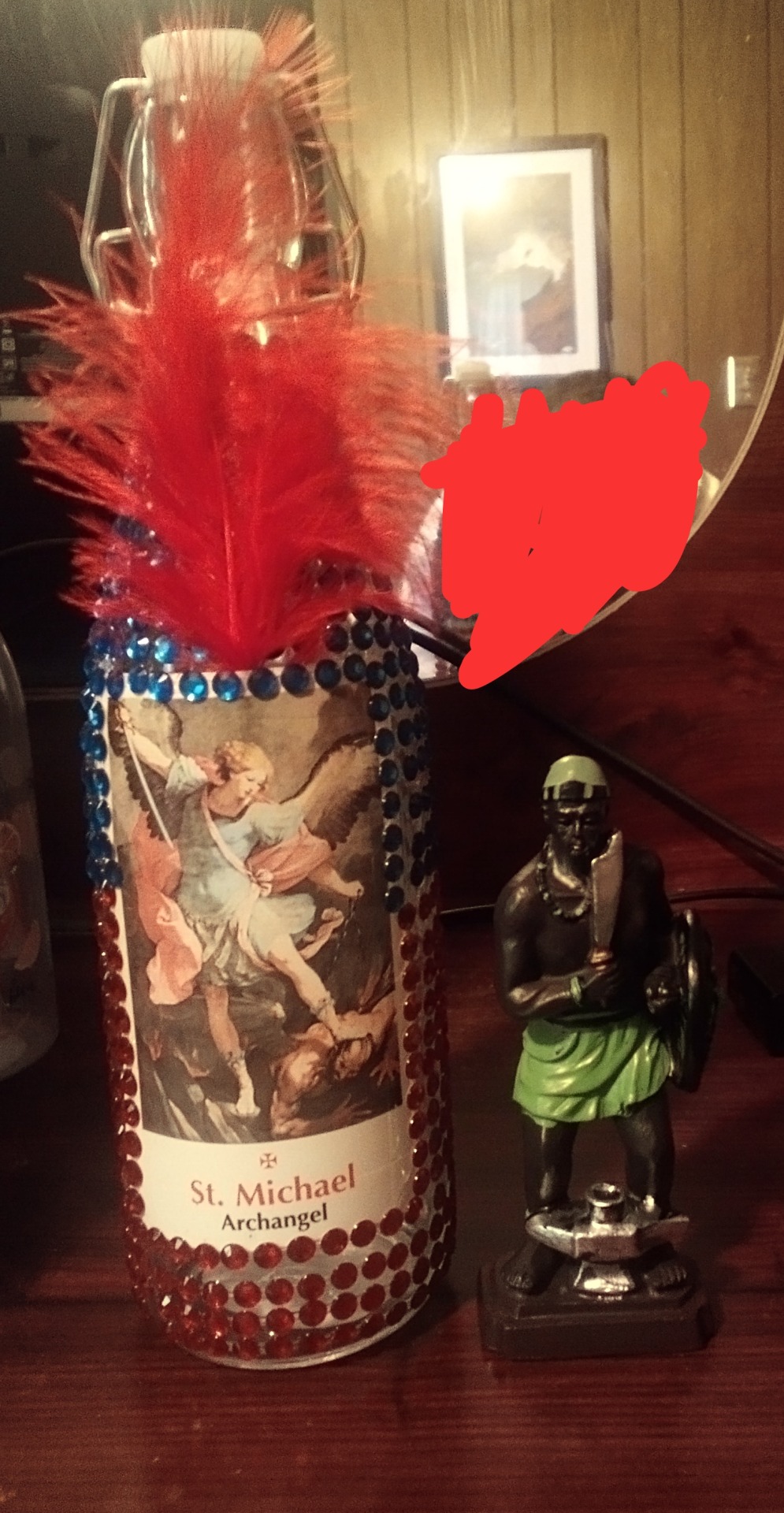

(left) A bottle I made of St. Michael aka Papa Ogou wit Ogun Statue. (Right) Other spirit bottles.
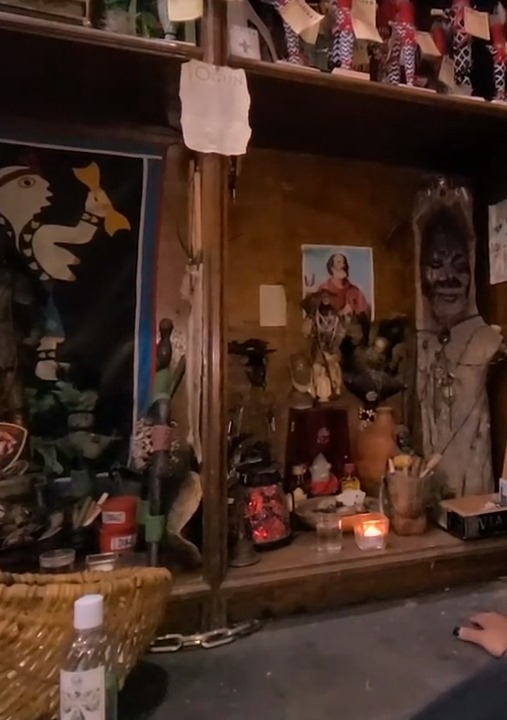
Papa Legba altar. ☝️
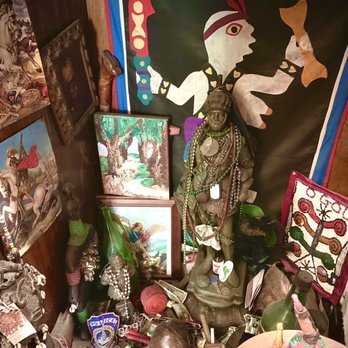

Ogou/ Ogun altars.

La Syrenn altar (below) & Yemaya Orisha altar (above)
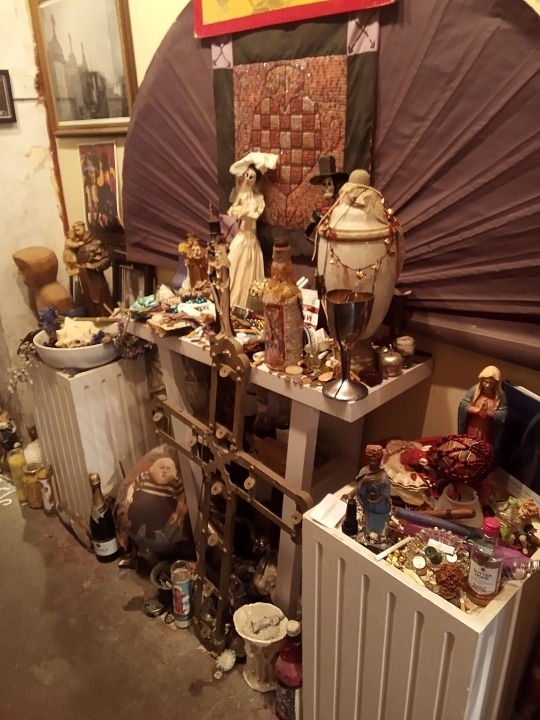
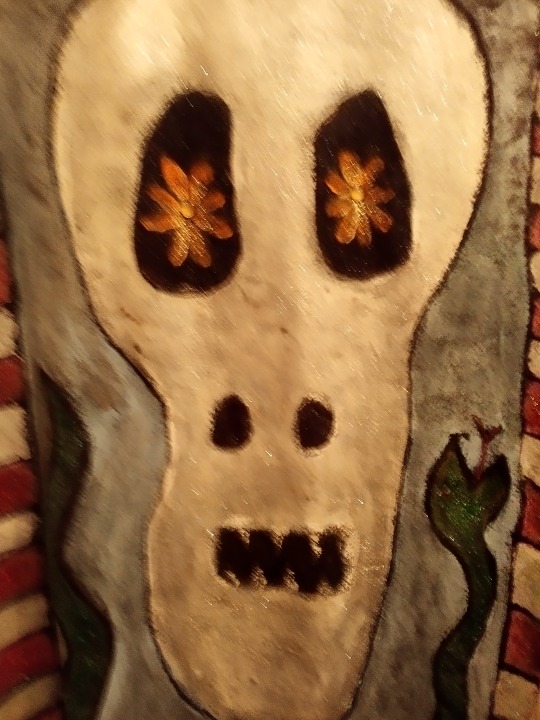
Muilty purpose New Orleans voodoo altar (left) Gede Painting (right)
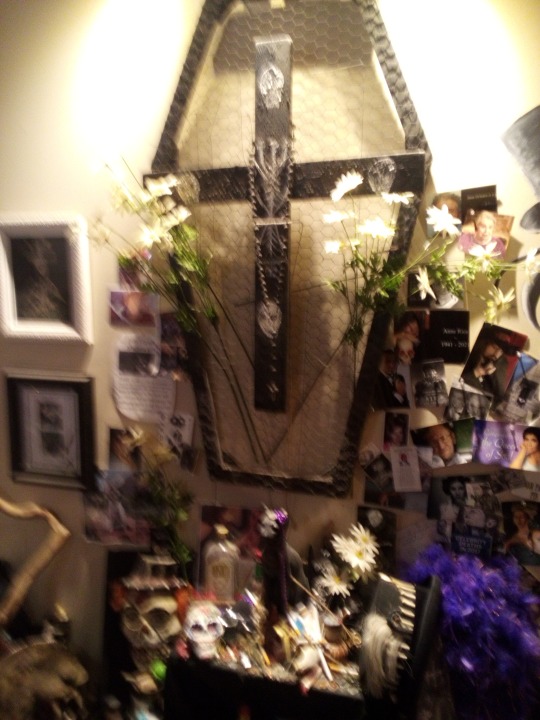
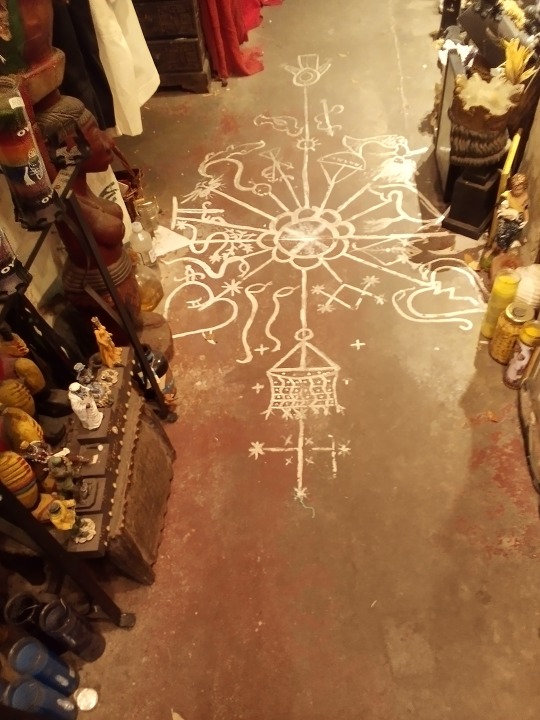
Pics I took of a Gede altar
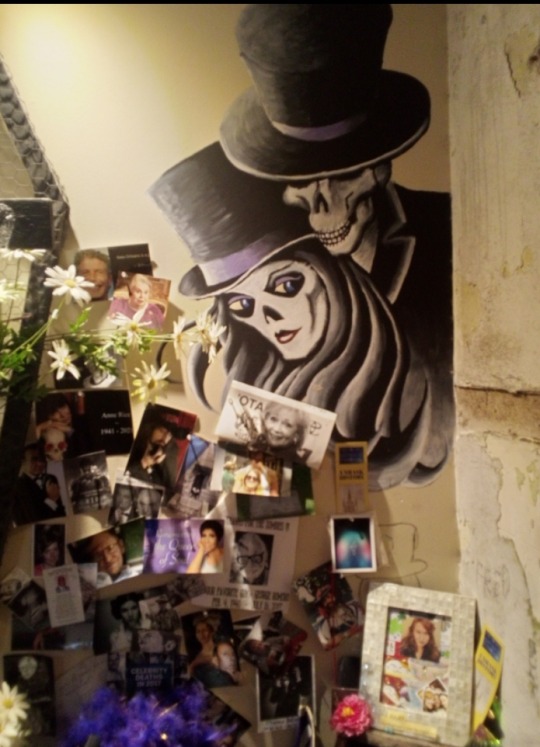
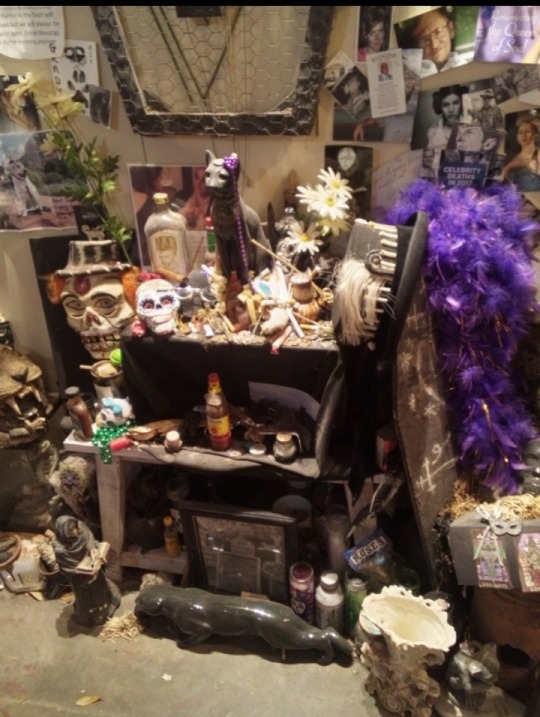
More pics I took of the Gede altar wit Papa Gede & Gran Brigitte.


Another Gede altar pic I took (left)
#Voodoo altars#New Orleans voodoo#spiritual#google search#like and/or reblog!#traditional hoodoo#southern hoodoo#Gede spirits#Legba altar#Elegba Altar#La Syrenn alter#Yemaya Altar#Ogou altar#Ogun altar#Spirit bottles#Vodou#follow my blog#ask questions please!#southern voodoo#Voodoo Societies#Spiritual altars
4 notes
·
View notes
Text
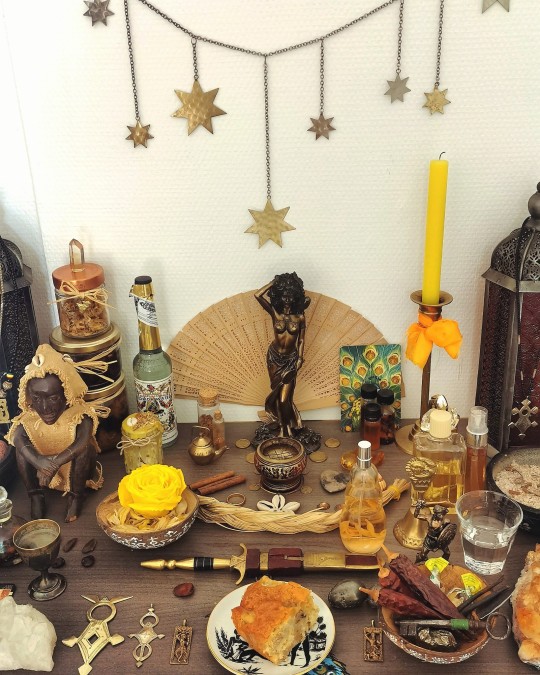
#oshungoddess#oshun#santeria#candomble#yoruba#ifa#aesthetic#atr#african traditional religions#orishas#ogun#hoodoo#african spirituality#afro witch#witches of color#west africa#florida water#oxum#keys#yellow flowers#iron#altar#my altar#offerings#blessings
103 notes
·
View notes
Text
Ogun’s Police Magic Force Spell
[Ogun, that prominent and versatile West African spirit, serves as a patron of police. Police officers may request his protection. However, depending upon circumstances, Ogun may also be prevailed upon to protect others from the police. The iron-handed spirit of justice and righteousness, Ogun is frequently syncretized with archangel Michael. An image of Michael may be used to represent Ogun providing Michael is depicted holding his lance or sword. The more traditional method of representing Ogun on an altar is with a piece of iron, such as a horseshoe, knife, or tool.]
Place a piece of iron on an altar.
Burn a double-action candle and some dragon’s blood incense.
Offer Papa Ogun over-proof rum and a good cigar and tell him what you need.
(from The Element Encyclopedia of 5,000 Spells by Judika Illes)
#spells#courtcase spells#protection spells#ogun#iron#candles#double action candles#dragons blood#dragon's blood#dragons blood incense#dragon's blood incense#rum#cigars
18 notes
·
View notes
Text
Celebration of World Isese Day in Yorubaland-Lagos, Oyo, Ogun & Osun |Attention: Ekiti, Ondo & Kwara
Happy Isese Day 2023 to all Yorubas both home and abroad. This is World Isese Day 2023.
Continue reading
Celebration of World Isese Day in Yorubaland-Lagos, Oyo, Ogun & Osun |Attention: Ekiti, Ondo & Kwara was first posted on August 21, 2023 at 6:09 pm.
©2022 "Orisha Online Altar". Use of this feed is for personal non-commercial use only. If you are not reading this article in your feed reader, then the site is guilty of copyright infringement. Please contact me at [email protected]
0 notes
Text

Shango is the immensely powerful Lord of Thunder, Lightning, and Fire. Lover boy supreme, Shango epitomizes virility, male beauty, and procreative energy. Petition him to share a little of his essence: he provides fertility, luck in love, and male sexual prowess. Shango is invoked for courage and justice. In Yoruba cosmology, lightning is understood as an instrument of divine justice, retribution, and protection. As the wielder of lightning, Shango provides victory over enemies and protects from all evil. Shango breaks hexes, curses, and evil spells.
Shango exults in warfare, competitive sports, martial arts, and dancing. He is a ladies’ man and a musician. Legend has it that he created the very first set of bata drums. Shango is proud, temperamental, volatile, a womanizer, amazingly generous, compassionate, and tireless on behalf of those he loves.
Shango is among the most beloved of all or-ishas. Two distinct African Diaspora religions bear his name: Trinidad’s Shango, and Xango of Recife, Brazil. In the Brazilian spiritual tradition, Umbanda, Xango (Brazilian spelling) leads the second of Seven Lines. The exception is Haiti where Shango plays second fiddle to his great rival, Ogun.
Shango’s consorts include Oba, Oshun, and Oya. Yemaya may or may not be his mother. He has a tense relationship with Ogun. Some, although not all, traditions consider them to be mortal enemies: it is usually considered advisable to keep some distance between these two alpha male spirits. (They are, however, invoked together as members of the Seven African Powers.)
The orisha Shango has had at least one human incarnation. The historical Shango was the fifteenth-century fourth king of Oyo, now part of eastern Nigeria. Depending on the version of the myth, the king was an avatar of the preexisting orisha or Shango became an orisha after the king’s tragic death.
The Nigerian government placed a statue of Shango at Kainji Dam to celebrate the power lines.
King Shango, a master of psychological warfare, was a beloved military commander. He was also a magical adept who had access to powers of fire and lightning. There are different versions of how his reign and life ended. His associations with magic may have cost him his throne: exiled by the elders of Oyo, friends, and sycophants alike deserted him. When even Oya, his most faithful supporter, doubted him, he killed himself. Alternatively, while experimenting with the powers of lightning, Shango accidentally burned down his palace with all his wives and children inside. Grief stricken, he killed himself, sometimes as a double-suicide with Oya (who may have provided the firepower).
In Africa, Shango once disguised himself as Oya to escape his enemies. In Cuba, Shango disguised himself as Saint Barbara in order to make himself accessible to his devotees and preserve his power. Shango is syncretized to the virgin martyr, with whom he shares associations with lightning. (To confuse matters more, Oya sometimes wears the mask of Saint Barbara as well.) Shango is also syncretized to Saint Jerome as well as to John the Baptist in some Haitian traditions.
• Shango is associated with the Afro-Brazilian spiritual-martial art, Capoeira.
• Place thunderstones or Neolithic axes on Shango’s altars to activate them.
Also known as:
Chango; Xango; Oba Koso (“The King Does Not Hang”)
Origin:
Yoruba
Classification:
Orisha
Favored people:
Dancers, drummers, twins. Shango is patron of Trinidad and Tobago.
Manifestation:
Shango typically appears as an incredibly handsome, charismatic man. He often wears a red coat covered with cowrie shells.
Attributes:
Lightning, double-ax (labrys), club, mortar. Shango divines via a magic pestle.
Emblems:
Thunderstones, meteorites
Color:
Red and white—in Yoruba cosmology, this indicates the balance between aggression and compassion, respectively.
Metal:
Copper
Animals:
Horse, ram, turtle, lizard, leopard, crocodile
Bird:
Pheasant, rooster
Mount:
Shango rides a magical white stallion named Eshinla.
Trees:
Royal palm; banyan; ironwood; banana
Plants:
Mugwort (Artemisia vulgaris); Ipomoea jalapa, also known as High John the Conqueror
Day:
Wednesday, Friday, or Saturday depending upon the tradition
Number:
6
Elements:
Fire, wood
Planets:
Sun, Mars
Petitions:
Those made during a thunderstorm are most effective.
Altar:
His special place in the home is the fireplace or hearth.
Offerings:
Shango likes his food spicy and his portions large. Offer red foods, like red apples and red palm oil. His favorite meals include yams, corn, and peppers as well as cooked crab. He drinks red wine, rum, and cachaça. Other offerings include cascarilla powder (powdered eggshell) and sugarcane.
363 notes
·
View notes
Text
Mindful Consumption of Hazbin Hotel’s vodoo Content
There is no such thing as Voodoo; it is a silly lie invented by you whites to injure us. —William Seabrook, The Magic Island
(Article and Study Link Sources will be in the reblogs because Tumblr doesn’t let linked posts appear)
First of all, I’m not writing this as a Vodou practitioner. Or as a Creole POC. I’m simply an outsider making an effort to educate herself for mindful consumption of Hazbin Hotel content and avoid perpetuating misrepresentation of a religion.

(Image: Alastor with Vodou symbols and Vodou-inspired symbols behind him)
The portrayed dark magic of Hazbin Hotel’s Alastor is heavily themed with Hollywood Voodoo or the misrepresentation of Vodou in film. This can also apply with Dr. Facilier in “The Princess and the Frog.” Both characters are from New Orleans [18], [19] where Louisiana Vodou Vaudou is practiced. Both are therefore assumed to practice an evil version of said religion.
During my consumption of Hazbin Hotel content, someone once pointed out the worrying factor of Alastor’s magic abilities identified as Hollywood Voodoo.
According to my research, Hollywood Voodoo is a film outlet of “Imagined Voodoo” or the age-old White anxieties on Black people.
What Is Vodou?

(Photo taken from Huffpost)
Haitian Vodou is a religion of African descendants brought as slaves to the French colony of Haiti. It combines west and west central African religions with Native American and European cultural and religious elements.[1]
It is also known as Vodoo, Vodoun, Vudu and Vudun. But to avoid confusion, the term “Vodou” will be used consistently throughout this post when referring to the religion.
Slaves from Haiti are brought to New Orleans where it infused with its dominant religion, Catholicism. The Vodou-Catholicism hybrid religion is sometimes referred to as New Orleans Vodou.[2]

(Photo provided by Cheryl Gerber)
All Vodou rituals are healing rituals. It's focused on the celebration of ancestral spirits (Lwa or Loa) through feasting, singing and ecstatic dance rituals to heal ailments and restore social bonds.[1]
Vodou practitioners believe of the visible world connected to the invisible world that can be transitioned to through Death. In the invisible world, the Lwa watch over and inspire us. The Lwa can be archetypes of human personalities such as Ogun the Warrior or predecessors. There is also the Bondye or their version of the supreme God who is loving but distant from individual human concerns. [3]
But despite this, a majority of foreigners synonimize “voodoo” with Haitian “black magic” or “sorcery.”[4]
What is Imagined Voodoo?
A Harvard study termed "Imagined Voodoo" to refer to the imagined religion and magical system of the American brain linked by the following White anxieties:
Black uprising
Black fetishization
Intermarriages that could lead to the dissolution of the White race
All under the guise of history or harmless entertainment, it negatively affects Black religiosity and in general, Black subjects. Unless we arm ourselves with information to prevent its perpetuation through us.
Alastor’s Themes and Voodoo Stereotypes
Stereotypes are often used in stories to save time on informing the audience through widely held and fixed oversimplified assumptions. The following Voodoo stereotypes are present in Alastor’s character traits and themes.
His Roots
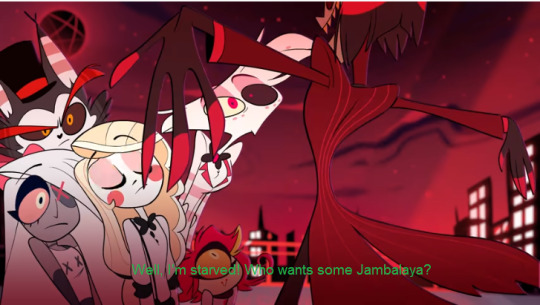
According to Alastor’s Wikia page, he is part Creole.[20] In New Orleans, the term can refer to many kinds of people. In early history, "Creole" is a term for:
A slave born in the New World[5]
A free Person of Color[5]
People of Mixed Heritage[5]
Later on, White French and Spanish people residing in New Orleans adopted the term to differentiate themselves from Americans whom they found greedy and ambitious.[5]
A Creole person can be White, a POC or of mixed race from different places such as Haiti and Louisiana.
The team behind Hazbin Hotel may have made Alastor part Creole in order to avoid religion appropriation. However, Vodou is not an exclusive religion. [6] (EDIT: Vodou is an exclusive religion.) And even if they want to represent mixed Creole people, pairing Alastor with Hollywood Voodoo may not be a good way to do it.
Vodou practitioners today are targets of hate crime, especially in Haiti (sacred mapou trees are regular targets of vandalism and arson, worshippers risk harassment and violence, with lynchings not unheard of).[7] If the media continues to portray Vodou as evil, it may have a role in perpetuating the hate.
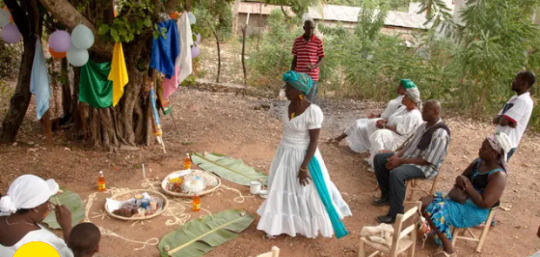
(Image of a Vodou ceremony from a video of The Guardian)
Depicted As Evil Magic

In America and Caribbean, Vodou was first practiced by slaves of African descent. Their religion was dismissed as superstition, their priests as witch doctors and their God and Lwa were denounced as evil. [3]
“They were treated as cattle. As animals to be bought and sold; worth nothing more than a cow. Often less,” anthropologist Ira Lowenthal stated.[7]
“Vodou is the response to that. Vodou says ‘no, I’m not a cow. Cows cannot dance, cows do not sing. Cows cannot become God. Not only am I a human being – I’m considerably more human than you. Watch me create divinity in this world you have given me that is so ugly and so hard. Watch me become God in front of your eyes.’”[7]
During the Haitian Revolution, many of the slaves were Voodooists and some of their military leaders were priests who inspired and organized them to fight for freedom. The imagery and vocabulary of Vodou became threatening to European and American colonies and was then brutally repressed. [3]

(Image from Lisapo Ya Kama)
Years later, Hollywood Voodoo is rooted in racism and acts as an outlet for White anxiety of Black vengeance. One example is the movie, “The Skeleton Key” where Black hoodoo practitioners (who had been lynched) stole the bodies and identities of White people for years.
For Alastor to continue using Hollywood Voodoo themed magic may continue the misinformation of Vodou by inspiring baseless fear and horror.
Voodoo Dolls and Pins

Voodoo dolls are universally associated with Hollywood voodoo and therefore, Vodou. But voodoo dolls are unheard of in the original Haitian Vodou.
In reality, they were inspired from the "poppet" of European witchcraft after an American writer heard Vodou is a witchcraft [8]. This American writer is most likely Victor Hugo Halperin where voodoo dolls first appeared in White Zombie (1932) [9].
Dolls are used in Vodou but only to represent Lwa and Bondye, sometimes the dolls are nailed on graves and altars, in order for the practitioners to communicate with them. The dolls also act as lucky charms and are not used to curse or cause harm with pins. [10], [21]

Cannibalism
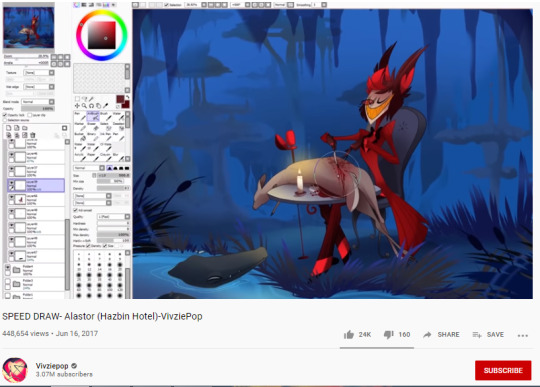
(Screenshot of Alastor the Deer Demon eating a deer)
On February 13, 1864, 4 men and 4 women were executed for abducting, murdering and cannibalizing a 12-year-old girl by Fabre Geffrad, Haiti's reformist president, who wished to make an example out of the 8 killers labelled as vodouists and leave the backwardness of its African past and its folk religion. With Haiti claiming their independence, the Westerns' view on Vodou was proof that the "black republic '' cannot claim to be civilized.[11]
No transcripts of the trial survive. The most detailed account of the crime was written by Sir Spenser St John, the British charge d'affaires in Port-au-Prince -the place nearby the village where the murder happened. It was his account that defined Haiti as a place where ritual murder and cannibalism were common and often goes unpunished.[11]

(An artist’s engraving of the 8 “voodoo” practitioners found guilty of the murder and cannibalism of the 12-year-old Claircine from the Smithsonian Magazine.)
However, there was no other information supporting St. John's claim that cannibalism is a norm for 19th century Haiti. The only two reports of cannibalism provided was from a French priest in 1870s and a white Dominican ten years later. Both have no evidence and both are suspected from their claim that they have penetrated secret ceremonies wearing blackface -if they have been undetected. However, they have influenced Victorian writers who have never visited Haiti.[11]
In the 19th century, American Jesuit missionary, Joseph W. Williams claims that sexual arousal from voodoo "orgies" causes devolution to lower animal states that causes them to cannibalize in an act of sexualized violence.[1]
In Joseph Murphy's psychoanalysis, Imagined Voodoo allows White people to project their most disturbing desires onto a cultural Other.[13]
"The erotic and ecstatic elements in African-derived religions are selected and transformed into images of unrestraint and become vehicles for white sexual and aggressive fantasies... What is ‘dark’ and ‘black’ within the white psyche is projected onto what is ‘dark’ and ‘black’ in the social environment."[13]
Because of the accusations of cannibalism, Vodou is seen as savage. Alastor is hinted to be cannibalistic (as seen by a speed drawing of him, a deer demon, eating a deer).[12] To continue to associate cannibalism with voodoo practice may continue the harm of misinformation.
Vodou Symbols
When Alastor uses magic, Vodou symbols or veves would sometimes appear.
In Vodou, different veves are used depending on the lwa or spirits the practitioners desired to invoke.

(Veve image from Catherine Beyer)
Damballah-Wedo is believed by the Vodou practitioners as the Sky Father and primordial creator of all life. He is depicted as a snake or serpent and is seen as a loving father of the world whose presence brings peace and harmony. [23]

(Veve image from Catherine Beyer)
A part of a veve in the screenshot is from the veve for Papa Legba -the gatekeeper of the spirt world. He is associated with the sun and is seen as a life-giver that transfers the power of Bondye to the living world. Rituals are started by praying to Legba to open the gates so that they can connect to the other lwas. [23]

(Ayizan Voudou Veve copyright 2009 Denise Alvarado, All rights reserved worldwide.)
The veve above is the veve of Ayizan. Ayizan is the lwa of commerce and herbal healing. She is associated with love and Vodou rites of initiation. Ayizan is believed to be the first archetypal mambo (priestess) and the protector of religious ceremonies.[14]
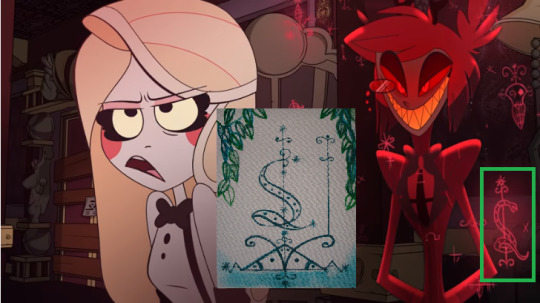
(Veve Image from ErzulieRedEyesArtAndSpirit)
The veve above is taken from the veve of Papa Loko. He is believed to be the first Vodou priest. His name has nothing to do with the American (EDIT: Spanish) slang word "loco" meaning crazy. Papa Loko is a revered knowledgeable spirit who offers spiritual guidance to those seeking formal initiation into Vodou.[15]

Met Kalfou is the master of the Crossroads. He is the crossroads where magic manifests regardless of which lwa is using magic for. He allows it to travel without judgement.[16]
Met Kalfou is often mistaken as some kind of demon or evil. He is believed to be the force through which all magic flows, be it good or ill. Met Kalfou is also the spirit of luck. As a manifestation of crossroads, he can see multiple outcomes of a situation. [16]

Santa Muerte is believed to be the personification of death itself.[17]
Using veves to portray evil when it incorrectly relates to what they symbolize can result in misinformation. Even if only parts of the veve are taken to be used to portray malice, it doesn’t change the fact that they still came from sacred symbols.
Is Alastor a Hoodoo Practitioner?

(Photo: Image of Hoodoo Candles from Wikipedia)
Hoodoo is based heavily on folk magic. It is not a religion. Although their beliefs have elements of African and European religions. Its tradition emphasizes on personal magical power with the intention to improve daily lives. Its a combination of African practices and beliefs and American Indian botanical knowledge and European folklore. It’s heavily practiced in the Southern US.[22]
Unlike Vodou, they have no designated priests or priestesses and no difference between initiates and laity. Hoodoo spells are commonly accompanied with Biblical text but are not performed in Jesus’ name. It uses tools, spells, formulas, methods, techniques. Tools can be herbs, roots, minerals, animal parts and personal possessions.[22]
Alastor MAYBE a hodoo practitioner. But there are possible problems of associating an occult of a minority as a tool of evil. It might be best if Alastor is only depicted using deer-radio-themed dark magic instead.
In Short...
Misrepresentation of Vodou has its roots on White fear of Black retribution as well as White “othering” and projecting of taboo concepts such as fetishization and cannibalism. This results in stigmatization of Black topics and Vodou practitioners. The continuation of Hollywood Voodoo plays a role in perpetuating its misrepresentation. However, informing ourselves may stop the perpetuation in us.
#hazbin hotel#hazbin hotel alastor#hazbin alastor#hollywood voodoo#vodou#voodoo#hollywood racism#lynching tw#racism tw
1K notes
·
View notes
Photo

Other Names: Ochun, Oxum, Osun.
Oshun rules over rivers, love, romance, gold, pregnancy, witchcraft, healing, weight loss love, fertility, relationship, and love or wishing spells.
When individuals have writer's block, Oshun is an excellent Loa to petition. She is also the Orisha who we go to for spells for money matters. She is the youngest of the female Orishas but maintains the honor of Great Queen. Oshun heals with her sweet water and honey, infused with her spiritual power. They say Oshun saved the world by seducing Ogun and tempting him to back into the woods. Oshun is a messenger from Olodumare. For this purpose, no matter what Orisha governs their head, all who are admitted as priests, have to go to the river and give a statement to Oshun. She is characterized by the color scheme of yellow and gold. Her beaded necklaces vary, but normally include yellow, amber, green, and honey-colored beads, along with coral. Her attire is yellow or amber-colored with gold trim. Her number is five. Peacocks and vultures belong to her and are normally used to exemplify her. Pumpkins, honey, coconut, spinach, almonds yams, cinnamon, lemons, chicken, and Goldschlager Liquor are favorite offerings for Oshun and are associated with Our Lady of Charity. Oshun says she belonged to no man and thought all was fair in the game of love. You can create an altar for her with a yellow candle, cinnamon, anise, pumpkins, amber, coral, and cowries, and some honey that you should taste first since Oshun was poisoned by honey.
Symbols: Gold, Yellow Butterflies, Diamonds, Yellow Roses.
Feast Days: September 8th.
Planetary: Venus.
Astrology: Taurus and Virgo.
Tarot: Page of Cups, Ace, and Two of Cups.
Chakra: The Heart Chakra and Solar Plexus.
Corresponding Gemstones: Amber, Citrine, Diamonds, Imperial Topaz, Rutilated Quartz, Golden Beryl, Yellow Fluorite.
Animals: Yellow Butterflies, Bees, Otters, Skunks.
Tools: Gold, Combs, Mirrors, Jewelry.
Beings of Equivalent Strength: Greek goddess Aphrodite, the Babylonian goddess Ishtar, Roman goddess Venus, Norse goddess Freya, and other Goddesses of Love.
17 notes
·
View notes
Photo

POWERFUL! Family, how many National Flag motifs do you know are based on Cosmic understandings? #Repost @vodou_film • • • • • • Vodou always reflects our Cosmic connection - have you identified and living yours? "Found in most hounfo and wogatwa (personal and family altars), the national flag found its meaning in esoterism. The dark blue symbolizes cosmic energy, particularly in the form of the ”female" deity, Ezili Danto, which represents maternal love and collective welfare. The dark red represents Ogou Feray, the iron will necessary in warfare.” - The Spirit of the Thing, Patrick Bellegarde-Smith, PhD #vodou #cosmicconsciousness #flag #flagstone #cosmicmind #identify #dark #blue #female #femaleempowerment #ezili #erzilidantor #maternal #matriarch #red #ogun #ogouferay #male #maleempowerment #iron #ironman #success https://www.instagram.com/p/CNbETuCj2e1/?igshid=1ujlvc23ta955
#repost#vodou#cosmicconsciousness#flag#flagstone#cosmicmind#identify#dark#blue#female#femaleempowerment#ezili#erzilidantor#maternal#matriarch#red#ogun#ogouferay#male#maleempowerment#iron#ironman#success
8 notes
·
View notes
Text
Alastor Ascension Arc
Alastor Ascension Arc
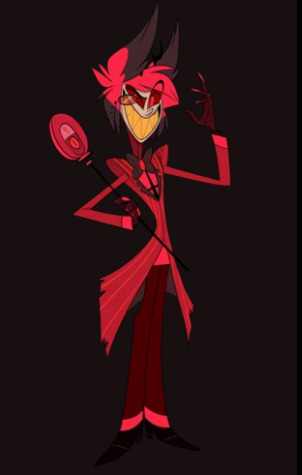
Part 1: 1896-1933 Human Life in New Orleans
Part 2: 1933 Arrival in Hell
Part 3: 1933-1940s Meeting Rosie and Mimzy
Part 4: 1950-1952 Making a Deal with Niffty
Part 5: 1953-1966 Alastor vs Vox
Part 6: 1970-1975: Making a Deal with Husk
Part 7: Alastor Prequel Comic
Part 8: Alastor in the Pilot: That’s (Alastor’s) Entertainment!
Part 9: Alastor on Hazbinstagram
Part 10: Alastor’s Parents
Part 11: Three Vs Attack Pt 1
Part 12: Manipulating Charlie and the Magnes
Part 13: Evil Charlie Unleashed
Part 14: Alastor Temporarily Takes Over Hell
Part 15: Rosie’s Deception
Part 16: Eldritch Family Rise
Part 17: Three Vs Attack Pt 2
Part 18: Adina influences Alastor
Part 19: Heaven and Hell War, Alastor joins Hell’s rebellion
Part 20: Alastor’s Redemption – Mother Reunite and Heaven
Part 1: 1896-1933 Human Life in New Orleans
“Murder On The Air”
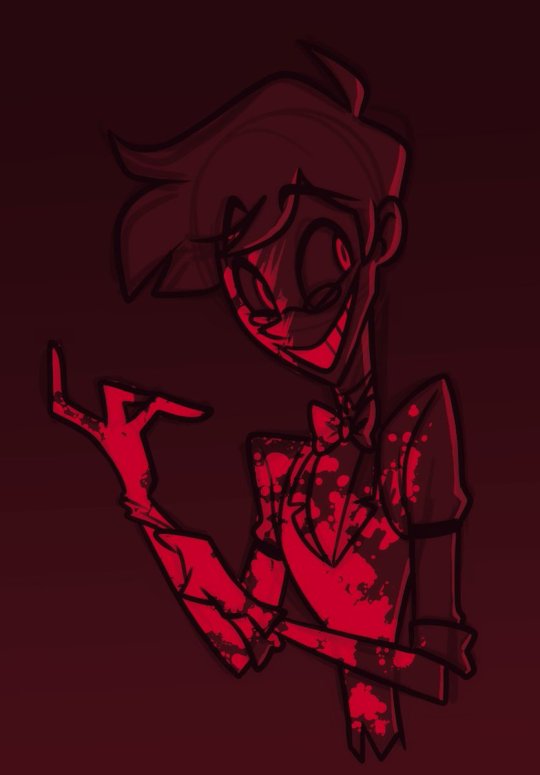
Art by Ashley Nicholas
“You’re Never Fully Dressed Without A Smile”
Chapter One: “Down in New Orleans”
Alastor Roscoe Moreau (A.M.) is born January 24th 1896 (VA born Jan 24th 1986) to his parents in New Orleans, Louisiana. Alastor has medium olive brown skin, short brown hair and brown eyes with glasses. He is lanky and thin but appears stronger than he looks. He often wears nice shirts with bow ties and dark pants and shoes. He wears overalls, boots and the occasional straw hat whenever he hunts or explores the woods and swamps outside. During his rise to fame, he wears fancy suits and top hats, complete with a microphone cane with golden antlers.
Armand Louis Moreau is Alastor’s French Canadian white father. He is a tall strong man with white skin, dark brown hair and a beard. His hobbies include going to church, hunting, taxidermy and drinking with his friends. Armand meets his wife and they soon fell in love. But Armand’s parents, Eugene and Manette disapprove of his interracial marriage. He becomes distant with them, only allowed to be back in the family when he divorces his wife.
Antoinette Loretta Moreau (formerly Duvalier) is Alastor’s French Creole mother. She has short curly black hair and dark brown skin, often wears cotton dresses and round ladies’ hats in bold red. She is part African American and part Native American and can speak Haitian Creole. In secret, away from her Christian husband, she asks her ancestors for guidance and reveres the Loa and saints, sitting at an altar she made. Antoinette’s white mother, Odette is a Voodoo Queen who reveres Yemaya and the saints. Odette’s husband, Mathis, is an African American musician, who later helps Alastor start a music career. Armand’s parents wanted Antoinette to abort her child as Alastor was perceived as a “troubled mixed child of sin,” but she refused. Manette offers to put Alastor in an insane asylum “for his own good”, but Antoinette fights back to keep him. Mathis was also wary of Alastor, but later grew to like him, while Alastor’s paternal grandparents always treated their grandson like he was stupid and dirty.
Antoinette is the one who taught Alastor all his favorite hobbies: cooking, sewing, Voodoo rituals, French and playing instruments. From her, Alastor learned how to play the piano, sing and dance while listening to the gramophone in their living room. At school, Alastor loved theater and leaned to play the trumpet, violin, saxophone, and piano. He also improves on his dancing and singing. Alastor is bullied for being mixed, doing women’s work and not liking girls.
New Orleans culture is introduced, along with popular festivals, 1900s language and Haitian Creole. Armand and Antoinette briefly talk in French as well.
Chapter Two: “Runnin’ Wild”
Early 1900’s Alastor’s youth
In his early innocent days, Alastor goes with his family to theater shows and Mardi Gras festivals. He eats king cake and watches jazz bands play. As a kid, Alastor is marveled by the colors, sights and sounds of the parades, costumes and delicious Creole food. Young Alastor is oblivious to the fact that others look down on the Moreau family for their interracial marriage. The insults affect Armand, reminding him of his chiding parents, but Antoinette insists that they must keep raising their son to be strong and kind. Alastor meets his uncle and aunt and cousins, celebrating St. John’s Day, Christmas and Fet Gede (All Soul’s Day). Alastor could often be found playing in the woods and the swamp. He even makes friends with the alligators while keeping a safe distance from them.
Chapter Three: “What a Wonderful World”
Early 1900’s more Alastor childhood and learning
Alastor’s mother teaches him how to make jambalaya and the dish becomes his favorite food. It nearly killed her when a drunken Antoinette put gunpowder in the pan and it blew up in her face. Antoinette would always tell Alastor, “You’re never fully dressed without a smile,” and Alastor smiled ever since. Alastor likes black coffee, hard liquor, deer meat and elegant meals. Alastor does not like tea, Oreos, strawberries, canned foods or anything sweet.
Alastor also learns Native American myths from his mother, including one about the Wendigo. (Alastor’s shadow and full demon form would be associated with the Wendigo monster).
For the only time in his life, Alastor enjoys being around dogs without fear. Despite being perceived as “abnormal” by many, he is one of the nicest kids around. He reads a lot, and really got into cookbooks and joke books. Alastor and his mother dance together to the gramophone, singing together in pure bliss.
Alastor starts school in 1901 at age 5. He learns Creole from his mother and some French as well.
When Alastor goes to school, he eventually joins the band, despite him being bullied by both whites and kids of color.
Chapter Four: “When The Saints Go Marching In”
Early 1900s, Voodoo rituals
Along with sewing, cooking, and dancing, Antoinette also teaches Alastor about Voodoo/Hoodoo rituals, along with his Grandmother Odette Duvalier.
Alastor sews Voodoo dolls (but doesn’t use them to harm others), collects animal parts and herbs, later using them to curse the houses and hideouts of criminals. He learns the veves of the Loa and conducts rituals with red and black candles. He uses alligator blood for healing magic.
Alastor learns how to consecrate objects, mediate in front of altars and how to connect with his ancestors. He learns of Antoinette’s Native American heritage. He eventually connects with the Loa, most of all to Met Kalfu, the fiery trickster Loa. He learns of his mother and grandmother being prominent Voodoo queens/figures in New Orleans. Antoinette had to curb back her involvement ever since she married Armand, but Odette still maintained her strong connection to the community. Antoinette and Alastor frequently do rituals out in nature, always showing respect to Papa Legba, the Loa of the Crossroads first. Ironically, the child-like Papa Legba and his dogs shared a spiritual connection with the young boy before Legba’s Petro aspect Kalfu took over as Alastor grew up.
(The dogs being part of Alastor’s death could represent the consequence of Alastor abandoning his innocence and former faith in his family/ancestors. The dog is sacred to Papa Legba and Ogun, Loa of iron and warriors/hunters).
Odette and Antoinette warn Alastor not to use magic and Voodoo for evil (which he later does anyway). His spirituality would reflect what path he goes down. Antoinette told Alastor that Voodoo magic is used for healing and guidance. Alastor formerly used Voodoo magic for good until being corrupted by the dark influences of the Goetic demons and Met Kalfu. Antoinette reveres the Rada Loa and discovers that Alastor has a spiritual connection to Met Kalfu, a Petro Loa. This explains Alastor’s affinity with fire magic.
Odette and Antoinette’s hidden magic is a reddish blue, the colors of the Petro and Rada mixed. Alastor’s magic eventually becomes Petro red. In 1919 after making deals with Gnostic demons Abaddon, Furfur etc. (kill souls on Earth as sacrifices to gain more power in the afterlife), his magic becomes exclusively evil and powerful. As a consequence, he loses touch with his ancestors and the other Loa after the deaths of his parents. (Souls can use magic in other worlds but lays dormant on Earth).
Alastor later gets his magic in hell with Kalfu’s influence and on Earth, he calls upon Ogun to assist him with using knives, axes and other weapons. None of the Loa accept human sacrifices but the Gnostic demons do, thus how Alastor gained more souls and eventual power.
Antoinette notices her husband slowly growing more distant from his son as Alastor bonds with her more.
Chapter Five: “Smile”
1903: age 7
At first, Armand is friendly with Alastor, watching with pride as he grows up. But as time goes on, he becomes more distant and harsh. Armand’s exposure to church made him believe that Alastor was a spawn of the Devil. He forces Alastor and his mother to memorize parts of the Bible and to pray to God every day. When they refuse, they get beaten up. Antoinette always cries in despair when she has to watch her son get beaten and whipped. She gets beaten up as well when she doesn’t clean the house or cook food to his liking. When Armand displays more “appropriate manly” behavior, he receives approval from his male friends and his parents.
During the better moments, Armand teaches Alastor how to hunt for game, prepare deer meat and skin deer for fur and deer heads. He also taught him some French. Armand has a taxidermy collection at the family cabin, even having his own business selling the stuffed prepared animals. He also teaches Alastor self-defense and how to run and be strong like a man. Alastor didn’t play sports like his father wanted but he was skilled at hunting and doing outdoor work.
Armand is mostly at work or with his buddies. Other than teaching Alastor skills in the woods, he doesn’t spend time with him. When he does interact, he chides his son for various things. Armand brings a hunting dog into the woods and the dog attacks Alastor, thinking he was a deer. Armand chides Alastor for not defending himself and being careless. This begins Alastor’s fear of dogs.
Chapter Six: “You Rascal You”
1906: age 10
As time goes on, Armand and Alastor begin to hate each other. Armand doesn’t like the fact that Alastor cooks and sews, calling it “women’s work.” Alastor’s love of theater and musicals doesn’t please him either. Alastor gets bullied for his heritage and interests at school. Armand stamps and breaks Alastor’s ribs when he doesn’t behave. Armand gets jealous that his wife seems to spend more time with Alastor. In darker moments, Armand soon begins drinking alcohol and hooking up with other women, even in their own home. When Alastor witnesses the horrific sight one night, his father beats him, whips him and molests him, calling him a “half-breed sissy faggot who likes other boys.” His mother comes in later and comforts him.
Alastor at a young age remembers the feeling of violation, his father’s hands on his waist and thrusting penis in his ass. This begins the cycle of trauma and Alastor’s aversion to people touching him, other than his mother. His mother soon finds out of his actions but can’t do anything about it as he is the head of household. Alastor’s mother sings “Smile” to her son as a song of comfort and lament. Alastor begins to think about killing his father.
Then one day when Alastor was ten years old (1906), Armand announces his divorce. He says that he will take most of the family income and the cabin, leaving Antoinette alone with her son and poorer. Having been pressured by his parents and wanting to reclaim his status in society as a white Christian man, Armand announces his leave.
Armand is about to leave one early morning to confirm the divorce when Alastor arrives. His father briefly beats him again, almost choking him to death and threatens to violate his mother as punishment. Not wanting his mother to go through more beatings and rapes, Alastor grabs the hunting rifle and shoots him square in the chest. The gunshot wakes his startled mother. Stunned at what he had done, he hides the evidence from her and promptly burns his father’s body. Though his mother has a suspicion it was him, she doesn’t say anything.
Chapter Seven: “Nobody Knows The Trouble I’ve Seen”
1909: age 13 Alastor witnesses discrimination
Alastor begins to play instruments and sing really well, his skills backed up by his mother’s teachings and the school band practices.
Alastor watches many old films including…
“The Great Train Robbery” (1903)
“Chased by Dogs” (1904) traumatized him/foreshadowing
“Satan Finds Mischief” (1908)
“Frankenstein” (1910) One of Alastor’s favorites as a teen, he emphasizes with the monster
“Oliver Twist”
“White Fawn’s Devotion” (1910)
“L’Inferno” (1911) another one of his favorites
“Peter Pan” (1924)
“The Phantom of the Opera” (1925) Watched it with Mimzy
“The Wizard of Oz” (1925)
“The Jazz Singer” (1927) One of his favorite musicals
“Sweeney Todd” (1928) Another silent crime film he enjoyed
“PopEye” (1929)
“King of Jazz” (1930)
“Dracula” (1931)
“Dr Jekyll and Mr. Hyde” (1932)
“Smilin’ Though” (1932)
“Murders in the Rue Morgue” (1932)
“Tarzan the Ape Man” (1932)
“The Big Broadcast” (1932) Alastor relates to the radio broadcaster main character
Radio City Music Hall started showing films in 1933.
Chapter Eight: “God Moves on the Water”
1912: age 16
Alastor witnesses the Titanic sinking in 1912, reading the newspaper (the same year that Baxter died). During the same year, he and his mother are forced to evacuate due to hurricanes. Alastor helps save people’s lives from drowning. They move closer to the city but their cabin in the woods remains intact. Alastor and his mother frequently pray to the Loa and saints associated with disasters.
World War One
World War One begins in 1914 right after Alastor graduates high school, and Alastor is drafted for it at age 18. He tearfully hugs his mother goodbye, unsure whether he’ll see her again. During his time there, he discovered the use of old radios used for communication. He was one of the soldiers who fixed and transported said radios on the front lines. Alastor watches several comrades die around him, the only thing keeping him sane is his task to operate the radios. After the war ended in 1918, Alastor returned to the city, now with more of an idea of his career. He applied to several radio stations but was rejected due to his race. But the Spanish Flu also occurred…
Chapter Nine: “Willow Weep For Me”
1918: age 22 Spanish Flu
…and when Alastor gets home in early November, he finds out his mother is gravely ill. He is able to embrace her as she says her final words: “Don’t be sad for me. Remember, you’re never fully dressed without a smile.” Heartbroken, Alastor is forced to bury her at a nearby cemetery as it rains. He kills two intruders in a blind rage and feeds their remains to the alligators in the bayou. He visits her grave and leaves offerings every October and November.
It is at this time that Alastor makes his deals with Kalfu, Furfur and Baron Samedi demons: wealth and power for the sacrifice of human souls. Only Furfur accepts human sacrifice, the Loa do not (they are not necessarily evil, they just want to help guide Alastor and teach him important lessons). Alastor is instructed to retrieve a grimoire in the afterlife that will seal the deal and grant him his powers (plus his shadow as he already had his microphone staff and basic radio powers beforehand).
Alastor even gets a chance to meet his cousin Dr. Facilier in the future (who later becomes his snake demon slave in Hell).
Alastor calls upon Baron Kriminel to help with getting revenge on those who tormented him and bullied him around. Alastor loses touch with his ancestors and the more beneficial Loa, opting instead to work with Furfur.
Chapter Ten: “Dr. Jazz”
1919: age 23
The Radio Corporation of America is founded in 1919. In 1922, WWL, Louisiana’s first radio station started broadcasting, founded by the Catholic Loyola University to help raise funds to build six new campus buildings.
Alastor dreams of becoming a jazz musician. Louis Armstrong becomes his role model and encourages him to join a band of his own. More people start to recognize his talent.
Axeman
Alastor takes care to avoid the Axeman killer and is spared from his attack by playing jazz every night. At one point, Alastor hacks a couple and copies the Axeman’s actions, leading to more panic in New Orleans. The rumors spread that the Axeman had killed twice as many victims, which was entertaining for Alastor as he reported it on the radio.
Time goes by (Roaring Twenties) and Alastor performs in an attempt to make some money. His uncle then connects with someone who works for CBS. More people flock to hear Alastor and his band perform. Alastor earns more money when he begins to fix radios for people. Alastor then applies for a radio DJ position but ends up getting stuck in a lower position, organizing files and cleaning up the studio rooms. Alastor kills off the higher ups and gets a position at NBC. He plays the top tunes but it soon gets boring. After getting fired, Alastor decides to broadcast on his own.
Chapter Eleven: “Sitting on Top of the World”
1920s: Young adulthood, career peak
During the Roaring Twenties, he would become the most famous radio host in Louisiana. Alastor often smokes both during work and during his free time. Alastor basks in wealth and fame.
Chapter Twelve: “Mack The Knife” (Alastor’s killing sprees)
1919, 1920: age 25 - 1933
During the Roaring Twenties, Alastor begins his killing spree of racist men, rapists, and criminals. He is called the Vigilante and the Louisiana Lunatic by those in New Orleans and kills his victims in various ways. Guns, knives, traps, and fire were his favorite tools to use. However, in this version, Alastor doesn’t kill women or children, he only uses them as tools.
Alastor flirts with women and manipulates them because it’s fun to do. People who made deals with him often found their money stolen by him. Many women are charmed by Alastor but Alastor doesn’t get intimate with any of them. He enjoys dancing with women, especially Mimzy. Alastor lavishes in wealth, buying new red suits and top hats, a fancy red car and a microphone cane with golden deer antlers. He also likes black, brown, blue, and green outfits. Alastor pulls pranks on people for fun (thumbtacks, kick me signs, soap in drinks, whoopee cushions, plastic doorways), some like it, some don’t.
Chapter Thirteen: “You’re Never Fully Dressed Without A Smile”
Chapter Fourteen: “Pack Up All Your Troubles and Smile, Smile, Smile!”
Alastor meets flapper woman Mimzy and the two bond over drinks, dancing, and singing. Alastor discovers that she killed her abusive husband and took his money. Mimzy finds out that Alastor kills criminals but she doesn’t say anything to anyone else.
Chapter Fifteen: “Charleston”
Mimzy and Alastor dance the Charleston.
Chapter Sixteen: “Let’s Misbehave”
Mimzy is deeply in love with Alastor, but he doesn’t love her back. He only sees her as a friend, which Mimzy doesn’t quite understand. She questions whether Alastor has a sexual disorder when Alastor tells her how he feels, which offends him. The two of them get intimate and nearly have sex but Alastor holds back, saying he’s not ready, much to her shock.
Chapter Seventeen: “Cold, Cold Heart”
Mimzy later dies after Alastor accidentally poisons her drink that was left for a racist man. Alasor would later sing with her and Rosie, bonding again in Hell. Alastor gets tired of people assuming he has a sexual disorder. Alastor was heartbroken at losing his only friend.
In this version, Alastor doesn’t eat people until Rosie introduces him to cannibalism in Hell via her elite group of associates. They later sing a cannibal song in Hell. Alastor is also not an Overlord and doesn’t go after women or children.
Chapter Eighteen: “When You’re Smiling”
Alastor cheerfully broadcasts peoples’ deaths on the air, not being found out until the thirties. On the radio, Alastor tells dad jokes, talks about special Creole recipes and always ends with the song “You’re Never Fully Dressed Without A Smile.” Alastor also talks about the Axeman and when he says “play jazz and I’ll spare your life.” Alastor takes great care to avoid the Axeman. Alastor also talks about Clementine’s killings and voodoo practices as well.
Hell, 1929
Esteemed Mortal of New Orleans: The Louisiana Lunatic
They have never caught me and they never will. They have never seen me, for I am invisible, even as the sound waves that surround your earth. I am not a human being, but a demon from the hottest hell. I am what you Orleanians call the Louisiana Lunatic. Down here, I’m the inevitable Radio Demon.
When I see fit, I shall appear and claim other victims as I see fit. I alone know whom they shall be. No clues will be left behind, save for what you might hear on the next broadcast.
Tell the police and the racist, elite scum of the world to beware. Let them try not to discover who I am, for it’d be better for them not to have been born than to incur the wrath of the Louisiana Lunatic. You’ll have a deer in the headlights look and won’t have any idea what hit you until after it’s too late.
Undoubtedly, you Orleanians think of me as a monster and murderer. But if I wanted to hurt anyone else here, I would have done so already. If I wished, I could pay a visit to your city every night. I could kill every one of your best and worst citizens, for I am in a close relationship with the Shadows of the Other Side.
At 6:06 pm next Friday night, I am going to pass over New Orleans and then visit those in Hell. I am going to make a little proposition to you people. Here it is:
I am very fond of jazz music, electro swing, and jambalaya. I swear by all the Loas and deities that I will spare those who can provide me with some great entertainment when I visit. Word of warning, I can read you people like a book, and see into your very souls. Anyone foolish enough to challenge me will have their corpses consumed and their screams muffled by the lovely sound of jazz bands jamming the night away.
I have been, am, and will be, the worst spirit that ever existed in fact, fantasy, or realm of Hazbins.
Smile and stay tuned!
Chapter Nineteen: “Crazy Rhythm”
The Great Depression comes into effect as well as the Stock Market Crash of 1929. Alastor enjoys reading about the chaos in the newspaper. People frantically sell their stuff and beg for jobs and money. He also enjoys seeing the orphans suffering homeless in the streets as it reminds him of his better off status. He also finds children annoying and undisciplined, a left over trait from his father.
But soon, things take a downward turn. Alastor begins to lose money and food, his former glory days over. Alastor hoards radios and radio furniture in his house. He grows bony thin and his eyes have bags under them. (He takes on a similar gaunt appearance arriving in Hell, remaining weak until he gains his powers and eats other demons. Magic also takes some of his energy.) Alastor grows unhealthy due to lack of food, and (almost!) resorts to cannibalism. He also fears losing his radio audience due to the prospects of TV. He meets Vox, an ABC broadcasting company CEO who taunts him for his race and career. They get into a fight but victorious Vox leaves, saying to him that his days are over.
Alastor becomes depressed, cutting into his skin for rituals or just to taste his own blood…to feel something. His self-inflicted cuts add to the scars on his back and body from his dad and struggling criminals.
Chapter Twenty: “Video Killed the Radio Star”
Alastor ironically dies when a full Hunter’s Moon is present. Alastor becomes more careless with his killings, and is soon discovered by police in 1933. The police sends dogs after him, a German Shepard, a Pit Bull, and a Black Lab. As he runs, he is bitten by a rabies infected dog in an alley. Alastor races through the snowy woods, experiencing painful headaches, and hallucinations of drowning and his parents being killed as deer. The police dogs bite at his legs but he shakes him off and runs some more. A deer hunter spots him, fearful and disgusted by the madman who rushes at him head on. (The hunter is Vox’s friend and the soon to be TV Overlord smirks). Alastor’s insane eyes beg the hunter to finish him off, as he didn’t want to be arrested. The hunter almost shoots him but finds he can’t do it. Vox then shoots Alastor between the eyes and his body falls. (Video Killed the Radio Star). The dogs maul at him moments before the gunshot before the police arrive. They turn him over and see the hole in his forehead, his glazed eyes, bloodied clothing and frozen smile. Alastor’s body is promptly burned, his belongings destroyed and his radios given away to an antique shop. His death is announced on his own radio station by none other than Vox before it, too, is done for. Many of his fans are saddened but the majority of New Orleans is relieved that he is gone. Vox is hailed as a hero before he returns to his job in another state.
(This is why Alastor hates Vox so much, not just because of their different tastes in technology!)
“You’re Never Fully Dressed Without A Smile” (finale)
A lone old fashioned radio (the one with the smiling grin on it and Alastor’s favorite radio) lights up in an antique store. His creepy voice says “Stay tuned” as the next part begins.
Part 2: 1933 Arrival in Hell
“Beware the Radio Demon”
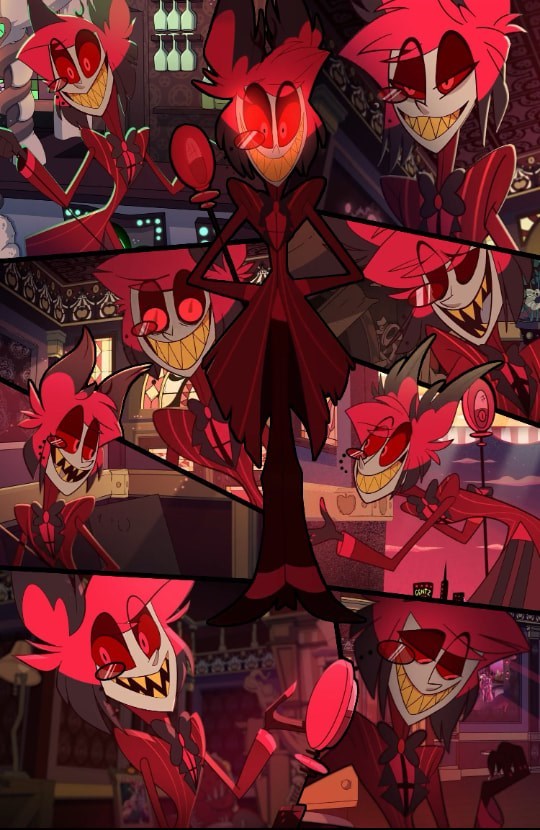
Tagline: “It’s time to tune in…”
Chapter One: “Heebie Jeebies”
Alastor arrives in Hell in 1933. He lands in the street between a jazz club and a strip club. He arrives naked and afraid, shocked by his new deer-like appearance. He has a black and red deer tail, antlers, red and black hair, sharp yellow teeth, red eyes, scarred gray back and chest, a regular size penis and gray scarred body. He is revolted by the tan gray gnarled state of his clawed hands and feet. When he talks, his voice has a radio filter, which surprises him. He realizes that it must be how he sounded to his audience. (Mimzy catches a peek at him but doesn’t yet know who he is). He summons his microphone staff, who is stunned to see Alastor nude. The microphone briefly glows, allowing Alastor to go on the air. Alastor realizes that Hell is a lot bigger and scarier than New Orleans. Demons mock him, including perverted ones. His memories coming back to him and instincts, Alastor quickly takes out the surrounding creeps with his bare hands, stealing their overalls and clothes. Alastor first wears brown too-loose pants and a white torn v neck shirt. So far, his only powers consist of controlling radios and brief bursts of fire.
Alastor then witnesses the harsh reality of Hell, daily discrimination, turf wars, killings, rapes and stealing. He then realizes that he has no place to live. It was the survival of the fittest from here on out. Alastor witnesses Tom Trench on TV, Sir Pentious and Baxter creating inventions, Mimzy performing at the jazz club and, of course, he learned of the royal family. Helsa and Seviathan and other Hell born spit at him, complaining that “common sinner scum” don’t belong in Hell. Alastor also sees a man with a radio head called Muse on an advertisement for 66.6 FM. Alastor gets mad that he was sent to Hell with his black stag demon father Neleus while his mother Poena got to go to heaven as a beautiful red doe humanoid sorceress.
Alastor camps out alone in the woods, deeply missing his mother and his old life. He wants to do something about all the sinners in Hell. A sense of duty came back to him…how he wanted to get rid of bad people, lost causes… an obligation to continue his work he had done on Earth. There were only a few people he could trust…and he decided to be untrustworthy and manipulative to everyone else.
Chapter Two: “All Of Me”
Alastor is reminded of what Furfur said after he sacrificed other humans to them on Earth. His microphone told him to find a grimoire that would allow him to summon Kalfu, and Abaddon to gain his magic. He asks a blue deer overlord and he tells him to look in Stolas’ palace, knowing that it was near impossible to get out alive. Rosie witnesses the conversation and decides to follow the sinner newcomer. Alastor sneaks into the palace to retrieve the grimoire, only to be caught by an angry Stolas. Alastor retrieves the book and is rescued from Stolas by a floating Rosie Poppins with an umbrella in her hands.
Alastor summons Kalfu, Baron Samedi and Furfur.
Furfur grants Alastor with heightened deer senses and destructive powers.
Baron Samedi grants Alastor with darkness and shadow powers.
Kalfu grants Alastor with fire and voodoo magic.
Alastor’s powers over radio were already his own when he arrived in Hell. This was why no mortal souls before him were seen with that much power; only powerful Hell-Born/Overlords had similar powers.
The prices Alastor paid for his powers were the collection of souls over the years, loss of his loved ones by fate, his own brutal death, being sent to Hell for his murders and a limit on his powers. Kalfu’s demons got a part of Alastor’s powers and Alastor can get tired after using a certain amount of energy. Alastor using blood magic drains energy, and he requires food, meat and rest to recover. Alastor can also be killed by angelic weapons.
Alastor’s powers include teleportation, shadow magic, portal creation, reality warping, conjuring fire and objects, possession, destructive magic, blood magic etc. The shadow demons get part of his power and after a painful separation, Alastor’s shadow is formed. The shadow, representative of Alastor’s darker thoughts, acts as a guide and bodyguard. Alastor creates his red tattered dress coat, black shoes with red deer tracks, his pants and his monocle. Alastor’s microphone allows him to be on the air anywhere to broadcast his massacres. The device reflects his mood as well, playing music and songs. The microphone can hypnotize demons who stare and listen to it and creates fatal radio waves that can blast brains out and destroy nearby buildings. With the help of his shadow, Alastor can travel from one shadow spot to another, through doorways and in small spaces. He can also travel through radios too.
In addition, Alastor can also shapeshift into others and into his red deer form. In his most powerful form, he appears as a bloodthirsty wendigo.
Alastor’s shadow is a manifestation of all his dark subconscious thoughts that are freed after he dies. The microphone staff is a manifestation of his radio host personality he had as a human. Alastor turned into a deer in Hell to remind him of his fate: “the hunter becomes the hunted.”
Chapter Three: “I’ve Got the World on a String”
Taking advantage, Alastor soon uses his powers to topple Overlords and take over many areas of Hell. He takes over 66.6FM, killing Muse and many Overlords (including Newspaper, Telephone, Clock, Car, Plane, Textile, Telegraph, Book and other Overlords. He makes a truce with the Overlord of Film.) Vox, Valentino and Velvet would arrive later. He forms an army of shadow demons and voodoo imps, his minions killing demons, burning stores, looting, feasting on deer and causing havoc.
Alastor becomes friends with the blue deer Overlord, a descendant of Furfur. The Overlord tells him where he can find his father, Neleus.
Alastor spends time with Lucifer too, drinking whisky, booze and singing. Lucifer likes polka music while Alastor prefers jazz. He treats Lilith well and watches as she performs on stage with her Resist band. (“God Spelled Backwards Is Dog”) Lucifer had been notified of Alastor’s powers and was intrigued. No mortal soul had power like the Hell Born elite before. Alastor even got a chance to dance with Lilith, him treating her like a lady and temporarily entranced by her beauty.
Alastor learned to stay on the king’s good side but can’t help getting curious about his unique daughter, Charlie. Lucifer talks about how Charlie sees the good in every sinner and her bond with Seviathan in Inferno high school (Charlie had not met Vaggie yet and Alastor wasn’t in love with Charlie, just curious about her, like finding a new specimen.). Knowing that getting too involved would lead to trouble, Alastor shrugs it off. Lucifer allows Alastor to do his chaos, provided he leave the royal family out of it, which he agrees.
Alastor makes deals with several demons and even temporarily gains access to Earth, gaining more souls. Alastor creates two hideouts: one a cabin with radio towers near a forest and an underground lair where the shadow spirits are (Deer’s Den).
Chapter Four: “The Axeman’s Jazz”
Alastor terrorizes Hell and uses an ax to kill off demons who don’t play jazz on his birthday. He even writes a letter similar to the Axeman’s letter:
Hell, 1933
They have never caught me and they never will. I am not a human being, but a demon from the hottest hell. I am what the Orleanians called the Louisiana Lunatic. Down here, I’m the inevitable Radio Demon.
When I see fit, I shall appear and claim other victims. I alone know whom they shall be. No clues will be left behind, save for what you might hear on the next broadcast.
Tell the Overlords and every sinner and Hell Born of the world to beware. Let them try not to discover who I am, for it’d be better for them not to have been born than to incur the wrath of the Radio Demon. You’ll have a deer in the headlights look and won’t have any idea what hit you until after it’s too late.
Undoubtedly, you denizens think of me as a monster and murderer. But if I wanted to hurt anyone else here, I would have done so already. If I wished, I could pay a visit to your city every night. I could kill every one of your best and worst citizens, for I am in a close relationship with the Shadows of the Other Side.
At 6:06 pm next Friday night, I am going to pass over Pentagram City. I am going to make a little proposition to you people. Here it is:
I am very fond of jazz music, electro swing, and jambalaya. I swear by all the Loas and deities that I will spare those who can provide me with some great entertainment when I visit. Word of warning, I can read you people like a book, and see into your very souls. Anyone foolish enough to challenge me will have their corpses consumed and their screams muffled by the lovely sound of jazz bands jamming the night away.
I have been, am, and will be, the worst spirit that ever existed.
Smile and stay tuned!
To make a deal with Alastor, call 666 - 024 - 1929 on your hellphone.
(Edward’s number is 24, 666 is the Beast number and 1929 is the year of the major Stock Market Crash)
Chapter One: “Practically Perfect In Every Way”
Hell Born Rosie Marie Poppins and Alastor properly meet shortly after he gains his powers. Rosie introduces Alastor to an elite group of cannibals, and Alastor happily accepts her invitation, thus further increasing his influence. Under the teachings of Rosie, Alastor learns how to increase his status, despite being a sinner. Due to being close to Rosie, less people insult Alastor as he walks by. He learns what it’s like to be a cannibal for the first time, and his hunger never ends since. Alastor begins to miss Kalfu and his Loa interactions (and his mother). He originally thought that he would pass through the seven gates of Guinee, the land of the dead in Loa culture. Rosie and Alastor bond over tea, coffee and murder. Rosie offers Alastor the position of Overlord but Alastor declines, as he wants to be free to wreak havoc without rules. He also shows a distaste for the greedy Overlords and authority figures. Rosie said that there are several sinners who are Overlords as well, but he still declines. Alastor would be his own Overlord!
“I was never destined to be part of any high hat group of leaders. I’ve worked exclusively for myself in my last life and will continue to do so in this one. With enough allies and the right timing, I could take them all down one by one. Besides, their meetings sound boring anyway.” - Alastor
Rosie used to work with her girlfriend Franklin until she died and Rosie got to own the shop for herself.
In return for Rosie helping Alastor get the spellbook, Alastor treats her like a lady and helps promote her emporium and spqeakeasy. Rosie recalls how she treats her employees cruelly and uses their wages to live a lavish life. Rosie is a cruel CEO who pursues rich and powerful men (and like the Dolly Sisters, she dances and performs as well). They both laugh as they share stories of taking advantage of other demons. Despite being Hell Born, Rosie does not treat Alastor with contempt due to his status as a sinner. (Or if she does, she hides it). Rosie becomes a stern-mother-like figure to Alastor, chiding him for any stupid mistakes he makes.
Rosie later gives Alastor advice such as being more open with Mimzy or to not fall for Charlie and be at the Hazbin Hotel (she finds the idea of redemption ridiculous. Despite this, Alastor still offers to help Charlie anyway due to seeking entertainment and potentially the trust of the royal family). Rosie also is a model for an All Soul’s Day/Death Day festival. Zombies, ghosts and other denizens watch as she poses on a blood red carpet in her rose garden. Like Day of the Dead, Death Day is a day to celebrate when sinners arrived in Hell and when the Hell-Born were born.
Unbeknownst to Alastor, Rosie secretly hopes she can gain some of Alastor’s power for herself so she can create Hell into a more orderly place where people admire her and her beauty. Deep down, she believes that Hell Born are superior to sinners, and would be pleased to see the lower class be her slaves! She forms an alliance with Lucifer, Lilith and the Eldritch family who are frequent buyers of her dresses and wares. Rosie works with Lucifer and the Eldritch family to try and bring Charlie down, saying her idea will never work. From Lucifer, Rosie learned of Charlie’s plan to redeem sinners. Redeeming sinners could mess up the hierarchy system and Rosie and the higher ups don’t want that. Her demonic form consists of a vulture like creature hovering in the air with an umbrella. Being in a position of power, it’s no surprise that she wants more of it! She even attempts to hold Mimzy and Charlie hostage to try and bring Alastor down.
Chapter Two: “Eat a Little Flesh Fantastic”
Alastor and Rosie sing the cannibal song after Rosie introduces Alastor to the elite cannibal group of Victorian ladies. Everyone dances like in the Mary Poppins movie as Rosie calls on her group members to ”go forth and feast.”
“Eat a Little Flesh Fantastic”
Alastor and Rosie strolled arm in arm after Rosie finished going to an Overlord meeting.
“Hey Alastor,” said Rosie turning to him. “Have you ever considered joining my exclusive club of socialites?”
“No, I haven’t…but do entertain me.”
“It’s mainly me and my group of ladies. We meet up for tea and coffee at this nice café not too far from here. We discuss the latest news, perhaps exchange jewelry or deserts.”
“Sounds lovely, my dear.”
“Oh and here’s the best part. My group and I have…exquisite tastes when it comes to meals. And I’ve heard about you and your slaughters.”
Alastor couldn’t help but puff up his chest in pride. “I was also a very skilled hunter in my other life. I’ve made many meals including jambalaya with venison in it. It is my favorite.”
A grin of sharp teeth stretched across Rosie’s pale face, her black eyes shining. “Have you ever considered eating the flesh of your victims?”
Alastor’s stomach growled at the thought. “I had a feeling that something was missing after I killed all those men as a human. I’ve hunted and ate deer and game many times. Perhaps I was too unsure about doing the same to other humans.”
Rosie laughed. “No restrictions now, though. This is Hell. Feel free to eat whatever…and whomever you’d like.”
Rosie handed him a blue arm of a nearby dead demon. Alastor maneuvered it into his mouth and sliced it to bits with several noisy bites. The sharp fangs effortlessly tore through the muscle and bone. The tangy taste of blood and juicy meat filled his mouth before he swallowed.
“That was quite tasty,” he remarked, licking his lips. Alastor then realized something extraordinary: there were countless demons roaming around in Hell. It was as if Hell had decided to provide him with an all-you-can-eat buffet. Not only would he have more meat to eat, but being a cannibal would also help with his fearsome reputation. Cannibalism was considered one of the worst taboos to do on Earth.
Why not add another sin to his list?
Alastor bowed and kissed Rosie on her hand in thanks. “Even in death, I learn something new every day. I’d be honored to join you.”
Rosie introduced Alastor to her group of friends: a bunch of demon women dressed in fancy Victorian dresses of many colors and round ladies’ hats on their heads. Violet, Lavender, and Poppy were some of their names. For a brief moment, Alastor felt like he was back in his time period on Earth. He ate demon meat to his heart’s content. Hell-Born or sinner, raw or cooked, it didn’t matter. He used the flesh and the sinner’s hearts in his jambalaya recipes. As the sinners had previously been human like Alastor used to be, he was now a cannibal.
The thought of someday tasting actual humans in the living world made his mouth water more.
On Sunday mornings after Alastor had coffee, he would be greeted by his new admirers while he walked outside, humming a cheery tune.
“Hello ladies,” Alastor said with a tip of his red top hat.
“Hello Alastor!” they chimed, as they sat on the ground in front of a mutilated body of a demon. One woman picked up the demon’s separated arm and used it to wave at him. Alastor chuckled and strolled on.
During one moonlit night, Alastor and Rosie decided to sing a song to strengthen their bond. They were already good friends, if not that then at least compatible associates with similar tastes. She looked like a gaunt Mary Poppins entering a Day of the Dead musical.
Rosie:
“Let’s say you’re bored and want to be full,
Sure, you can go about your day, dull. Or…
You can eat a little flesh fantastic with me.”
Alastor:
“If you live your days in wonder, but can’t focus due to hunger…
Just eat a little flesh fantastic with me.”
Rosie:
“For if you decide to kill a person, their body will someday rot away. But if you make haste and not let it go to waste…
Then you’ll be satiated for the day!”
Alastor:
“You don’t need to be Lector Hannibal, to consider the life of a cannibal.”
Rosie: “Want to be robust?”
Alastor: “You know I must.”
Both: “Come eat a little flesh fantastic with us!”
Rosie (speaking): “My fellow epicureans, answer my call. May your gluttonous desires led the way!”
“Welcome to the club, Radio Demon.”
Rosie and Alastor:
“The life of a cannibal
The feeling is so wonderful
Hunt and kill, munch, munch, munch,
A few screams later, you’ve got your lunch!”
“Have some style and show some class
It is us among the mass
When you’re feeling beat and want to eat
A demon can never have too much meat!”
“Eat a little flesh fantastic with us
Give in to another kind of lust
A sweet treat you are, come near or far
Our food as you bite the dust!”
Rosie:
“You can refrain and boldly exclaim
‘Eating your brethren’s not right!’”
Alastor:
“But we know well, to maim in Hell
The blood will be shed tonight!”
Rosie:
“The life of a cannibal,”
Alastor:
“The feeling is so wonderful,”
Rosie:
“Hunt and kill, munch, munch, munch…”
Both:
“A few screams later, you’ve got your lunch!”
“Eat a little flesh fantastic with us!”
(oh- oh- oh- oh- oh)
“Eat a little flesh fantastic with us!”
(oh- oh- oh- oh- oh)
Chapter Three: “Hello Mimzy!” (Hello Dolly! By Louis Armstrong)
Alastor bonds with Mimzy Dolly Hannigan at the jazz club and they recall their memories together in New Orleans. Mimzy works as an employer for Rosie at her emporium and squeak-easy. Rosie, enamored with Mimzy’s performance, decided to offer her a job to increase her influence. Like Alastor, Mimzy is more protected thanks to Rosie’s overlord status. Mimzy helps sell Rosie’s custom made clothes and antiques and performs almost every night at the underground bar behind Rosie’s shop. (Behind a door, down a stair-case. The password is “Practically perfect in every way.”)
Several times, Alastor and Mimzy dance and sing at the squeak-easy, to the joy of the crowd. At the squeak-easy, influential people and criminals gather there to discuss business, drink and have fun. Husk also goes there on occasion to serve drinks. Mimzy is popular both there and at her own jazz club: Mimzy’s Place. Rosie, herself, has performed there after her shifts. When asked if Rosie treats her cruelly, Mimzy says, “Almost never.”
Mimzy had died in the 1920s before Alastor. They agree to sing and stay friends, along with Rosie, creating a trio of singing, dancing, drinking and murder-spree-loving friends. They also terrorize orphans as they sing “Little Sinners” (Little Girls). Alastor apologizes for accidentally killing her and being aloof. Mimzy then apologizes for being too clingy with him and claiming that he didn’t know how to love back on Earth.
Mimzy lives a lavish lifestyle (like the Dolly Sisters, she pursues wealthy men and dances).
Alastor later offers Mimzy an invitation to visit the Hazbin Hotel and discusses the idea of redemption. Mimzy accepts his offer and decides to stay there, so long as she can still do her performances. Mimzy eventually becomes a guest at the Hazbin Hotel along with Baxter, Tom Trench, Molly, Arackniss, Cherri Bomb and Crymini. She bonds with Alastor, Niffty and Charlie as the girls gossip about men and the group performs in musicals together. Mimzy shares her story about being in New Orleans and with Alastor’s encouragement, she also thinks about pursuing redemption…as long as she gets more fame/recognition. Like Niffty, she gets jealous when Alastor pursues Charlie more. Mimzy thinks that Alastor loves Charlie more, but Rosie suspects he has another motive.
Alastor and Mimzy dance some more together and frequently perform at the jazz club.
Prequel Comic:
“Let’s go for a stroll.”
Comic by Liam (Pencils), Fautisse (Lineart), Lunetta (Colors), Magpie (Backgrounds) and Vivienne (Story).
Alastor enjoys coffee on a Sunday morning. Alastor hums down the street, goes to a café and watches birds fight over food. He stops to smell the roses, making one wilt with his touch. Everyone flees when they see him, making him a bit lonely inside. While visiting Rosie’s cannibal colony, he tosses his hat to the four admiring well-dressed women who eat a demon body. Alastor tosses a coin to a cat jazz player and swears after seeing Vox. He hates him so much, that his gentleman demeanor was gone. Alastor then saves a sheep demon lady from a butcher boar, kills the man, then enjoys the meat. (More to come)
Part 20: Alastor’s Redemption – Mother Reunite and Heaven
The villains eventually get defeated. (Assuming no one dies a second time) Eventually, Alastor gets redeemed and turns into a human/hart hybrid angel. Alastor never forgets about Charlie and how wonderful a person she was. They share a hug and kiss before Alastor leaves with his mother and Charlie stays to rule Hell. He reunites with his mother and they go to Heaven for a while. Alastor hosts shows in Heaven, and teaches the Angels how to make jambalaya and do dad jokes (He remarks their food is plain and boring). Alastor and his mother eventually depart for the seven Guinee gates with the Loa after they are accepted at last by Baron Samedi. For the only place where Alastor truly belonged was not Earth, Hell or Heaven, but with his family and culture.
Angel Dust gets to have private fun with guys in Heaven, while he continues to work on curbing his addicting habits. Molly, Arackniss, and Angel/Anthony reunite with their white spider mother Aranea. Husk finds true love with…Angel Dust! Husk performs magic shows for everyone and plays card games without betting as he has plenty of money and comfort. Alastor reunites with his mother and spends quality time with Mimzy before going to Guinee. (But Alastor will always remember Charlie!) Autumn, the Zoophobia deer and Alastor become friendly rivals. Vaggie reunites with her family (minus Valentino, her father) and marries another woman in happiness (but of course, never forgetting Charlie and what she did to help make their new lives comfortable!). Tom Trench, now mask free and blonde, hosts Holy 333 News. Zoophobia animal characters make cameos as denizens of Heaven. Sir Pentious or Baxter creates inventions and healing potion for the greater good instead of drugs and weapons and evil aquatic creatures. Roo and Cherri are BFFs along with Angel. Niffty marries a kind man in Heaven. All the characters take their time in healing from their wounds and experiences.
Vaggie, Angel Dust, Husk, Alastor, Baxter, Mimzy, Crymini, Roo, Villa, Tom Trench, Cherri Bomb, Arackniss and Molly all get redeemed. (Niffty may be is secretly evil). Charlie succeeds in redeeming sinners but eventually has to let her redeemed friends go.
I.M.P. and C.H.E.R.U.B. are still in business for many years. Blitzo lives his musical theater dream and Loona is by his side, arm in arm with Crymini.
Centuries later, Charlie marries a woman similar to Vaggie in Hell. Through a willing man, Charlie gives birth to two children who eventually take Charlie’s place as the Hotel managers when Charlie grows old. (Yes, she ages very slowly!) Her children are the next generation of do-gooders in Hell.
The show ends with all the characters dancing and singing under rainbows while “That’s a wrap!” shows up.
34 notes
·
View notes
Text
Toonami Weekly Recap 1/23/2021
SSSS.Gridman EP#02 - Restoration: Yuta and his friends discover that, in addition to all the damage being undone, nobody remembers the kaiju attack. In addition, several students are missing and nobody has any memory of them. After they decide to investigate, they are approached by a mysterious man named Samurai Calibur who "optimizes" Junk, allowing Rikka and Utsumi to see and hear Gridman. They investigate the missing students and find out that everybody's memories have been rewritten to believe they had all died before reaching high-school. Meanwhile, it is revealed that Yuta's classmate, Akane, and her electronic companion, Alexis, are behind the kaiju attack, which she instigated to kill the missing students for ruining her lunch. She then creates another kaiju to kill her homeroom teacher for not apologizing after bumping into her. Yuta once again fuses with Gridman to fight the Kaiju, but finds himself outmatched. This prompts Caliber to leap into Junk, transforming into a sword that Gridman uses to destroy the kaiju. The homeroom teacher survives the kaiju attack, and the next day, the damage and everybody's memories are reset like before.
Attack on Titan: The Final Season (Marley Arc) EP#03 (62) - The Door of Hope: Reclining on his bed, Reiner thinks about his past and a conversation he had with his mother on the curse of being an Eldian. He and his mother were abandoned by his Marleyan father, leading to the beginning of his quest to become an honorary Marleyan. He entered the military training program where selected trainees were chosen to become Titans; Annie Leonhart as the Female, Marcel Galliard as the Jaw, Zeke Jaeger as the Beast, Pieck Finger as the Cart and Bertolt Hoover as the Colossus. Porco Galliard was devastated when Reiner was chosen to be the Armored Titan, but Marcel had sabotaged Porco's chances for selection to spare his brother from the dangers of battle. General Magath sent Annie, Bertolt, Reiner, and Marcel on a mission to reclaim the Founding Titan on Paradis, but on arrival, Ymir, in the form of a Pure Titan, emerged from the ground and devoured Marcel. Annie and Bertolt wanted to abort the mission, but Reiner convinced them to proceed, leading to the breaching of Wall Maria. Following the mission, they reverted to their human forms and joined the Training Corps on Paradis. Emerging from recollections of his past, Reiner contemplates suicide, but reconsiders because of his role as a mentor to Falco and the other warrior cadets. Meanwhile, Falco engages in conversation with a wounded Eldian soldier who has lost a leg and an eye, but admits to faking trauma-induced amnesia to avoid being sent back home.
Sword Art Online: Alicization: War of Underworld Part 2 (Alicization Lasting) EP#21 (45) - Beyond Time: Rinko retrieves Alice's Lightcube, but Asuna informs her that she will stay behind in UW to be with Kirito, and the system enters the maximum acceleration phase. Meanwhile, Miller returns to the real world, just to find that his body is dead and his soul is dragged to Hell. Upon learning that both Miller and Vassago were ultimately defeated, Critter and the other remaining attackers decide to flee. Before fleeing, they rigged Ocean Turtle's main engine with explosives. However, Akihiko Kayaba takes possession of one of the installation's robots and successfully disarms the bomb. On their retreat, Critter finds out the other attackers never found Vassago's body. The robot used by Kayaba also disappears. Back in UW, Kirito and Asuna depart from the World's End Altar to explore the world together.
Fire Force Season 2 Chinese Peninsula Arc EP#09 (33) - The Core: Prologue: A retelling of The Great Cataclysm describes how after the world was enveloped in flames and ash, a man, later to be called Raffles I, led his followers to an "unsullied flame", an energy source which he used to create "Amaterasu" and benefit mankind. Back inside the Tabernacle Amaterasu, Victor tests Arthur's hypothesis that the code is based on "pi", but the results are inconclusive. They continue forward and reach the entrance to the core which emits a mechanical sound like a heartbeat. From the presence of white-feathered arrows, including one in the keyhole, Victor deduces that the core involves a sacrifice and may contain a living being possessing an Adolla Burst. Outside, Shinra and the others fight off the Infernals until only Tempe remains. Tempe creates a flaming scythe and attacks the Fire Force who seem powerless against him. Shinra still hears the voice telling him to save the forest so he asks Ogun, Tamaki and Takeru to delay Tempe while he and Scop attempt to contact the woman in black robes. He is finally successful, but she is so weak that she can only provide one second of Adolla Grace to help him. Shinra believes that will be just enough for him to defeat Tempe.
Assassination Classroom EP#18 - Action Time: Koro-sensei is forced to watch an hour-long movie edited and narrated by Kōki Mimura exposing all of Koro-sensei's embarrassing habits, used as a distraction from the chapel slowly filling with water and bloating up his tentacles. Once the students of Class 3-E shoot off the seven tentacles, they surround and block Koro-sensei with a hydraulic cage, allowing Chiba and Hayami to snipe him. However, Koro-sensei activates his ultimate defense, trapping himself in an indestructible crystal sphere, which will last for one day despite his limited movements. As the students lament their failed assassination attempt, many of them suddenly and severely fall ill. This is revealed to be the work of a mysterious third party who had spiked their drinks with a supposedly deadly virus, demanding that the remaining students and teachers bring him the immobilized Koro-sensei in exchange for the antidote. Deciding against the trade-off, Koro-sensei and Ritsu instead come up with a plan to infiltrate the high-security hotel and obtain the antidote.
#Toonami#Toonami Weekly Recap#SSSS.Gridman#Attack on Titan#Attack on Titan: The Final Season#Marley Arc#Sword Art Online#Sword Art Online: Alicization: War of Underworld#Fire Force#Fire Force 2#Chinese Peninsula Arc#Assassination Classroom
5 notes
·
View notes
Photo
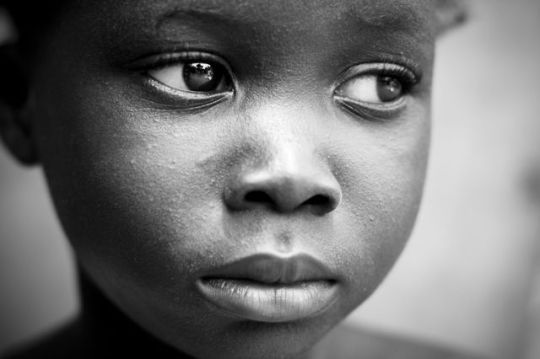
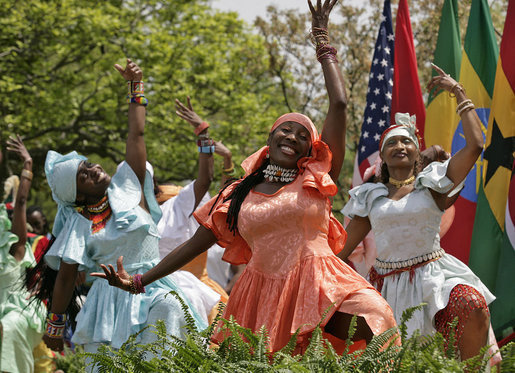

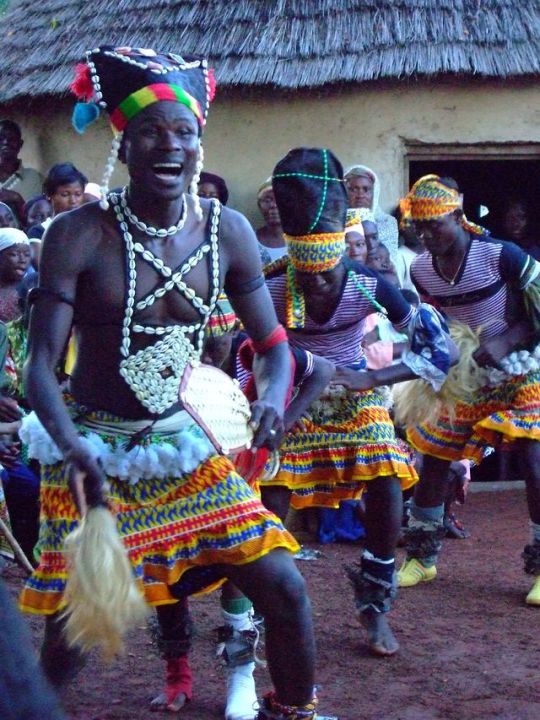
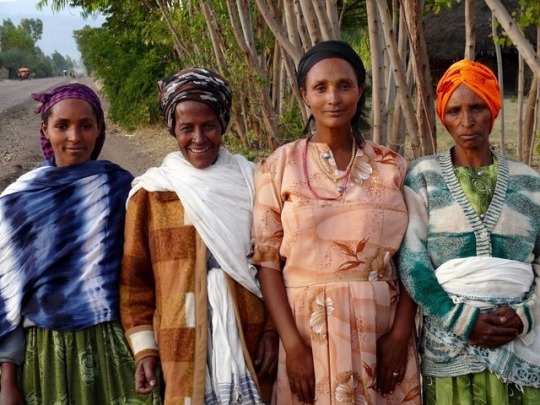
Christianity in Africa Jesus in the Morning, Voodoo in the Evening
The old natural religions continue to thrive in Africa. While Christianity and Islam vie for supremacy in many countries, they have failed to banish the rain gods and spirits south of the Sahara. Frequently the pagan rites have fused with a faith in Jesus Christ.
Six men in flowing white robes stride across the square in Maryal Bai. One village elder, his features gnarled, is wearing a leopard-skin hat. Akoon Duong is a priest, as are his five companions. To demonstrate his spiritual power the old man brandishes an elaborately carved spear, as do the other "spear masters" - the high priests of pagan nature worship. Akoon Duong has inherited these trappings of power from his grandfather, who in turn had received them from his own grandfather.
The men thrust their spears into the muddy ground and dance. One of them pounds out the beat on a bush drum. Scrawny arms flail upward, quivering in ecstasy. They render their songs in high, reedy voices. If there were a drought, they would have had to invoke Deng, the rain god. But this is the wet season; malaria can strike at any time, so they pray for deliverance from disease.
Maryal Bai is in southern Sudan, 15 miles from the no-go area between the Islamic government's militias and the guerrillas of the Sudan People's Liberation Army (SPLA). The village was the demarcation line for the recently ended North-South war and the escalating conflict in Darfur.
Just a few miles to the north, Sharia law - with its punishments extending from whipping to dismemberment - prevails. The South is mainly inhabited by Christians. For decades the region has been ravaged by fighting. Usually over matters of faith.
Camped along the majestic Gazelle River are thousands of refugees, the sableskinned, long-legged people of the Dinka tribe. Once they had fled to Darfur from the war in the South; now they are returning to the lands of their ancestors.
Time has stood still
The clash of civilizations and religions, the focus of so much debate in Europe and America, can be witnessed firsthand here in Africa. And today Maryal Bai is one of its many fronts. Islamic Fundamentalism is advancing from the west, penetrating all the way to the continent's eastern reaches. In some regions it collides head-on with an equally aggressive brand of Christianity. The clashes are becoming increasingly bitter because the desert is expanding, bringing more poverty in its wake. According to Georg Brunold, a Swiss expert on African affairs, a front line is crystallizing here that will spark "decades of war."
Yet, as hard as the two great monotheistic faiths have struggled for supremacy, they have failed to wrest power from priests like Akoon Duong. With its nature deities, the old African mythology is often the only stabilizing force in a world full of suffering, displacement and death, where everything is in constant flux but rarely changes for the better, where - in many respects - time has stood still. This is a world populated by nymphs and sirens, by elfin spirits, sun and moon gods, and by animal deities such as cows, stags, lambs and calves.
At the end of the 19th century, the British ethnologist Edward Burnett Tylor coined the term animism (the Latin word anima means soul or breath) to describe this pantheon, correctly assuming that plants, animals and objects also have souls in the minds of these "primitive peoples."
Cult of the dead
Despite the best efforts of Christian and Islamic missionaries, some 40 percent of the people in Burkina Faso, western Africa, are still considered animist. In East African Ethiopia, a largely Christian domain, the figure is still thought to be 10 percent. Yet these numbers remain pure conjecture. In truth, religious distinctions have long blurred, indeed evaporated, in Africa. Someone who attends church in the morning and the mosque at midday might easily invite a voodoo priest over in the evening to read the kola nuts.
DER SPIEGEL
Sub-Saharan Africa.
Practically everywhere the cult of the dead intermingles with Christianity, according to religious scholar Fritz Stenger from the Catholic University of East Africa in Nairobi. "There is scarcely any distinction between the secular and religious spheres; faith is omnipresent," says Stenger.
Should a child succumb to malaria, the relatives - according to Stenger - would partly blame the lack of effective medicine. However, the belief that its death was willed by God would carry greater weight. It is therefore no surprise that doctors attending to the sick often arrive with the preacher, medicine man and local sorcerer. Stenger, who has spent more than three decades in Africa, has observed this coexistence of divergent faiths throughout the so-called "Dark Continent."
In Kenya, for example, the modern minded Kikuyu, flashing cell phones and Ray-Bans, happily journey to Mount Kenya and pray to Ngai, the supreme God of the animists - despite often being members of one of the numerous Christian sects, such as the Pentecostals or the gospel churches. In this way, Stenger adds, Christianity and the pagan belief in nature deities and demons mutually impact one another. The existence of a god of creation in nearly all pre-Christian African religions encourages this process.
This cross-fertilization is not as strange as it may sound, even to Christians in the West. Something quite similar occurred there centuries ago, "when pagan Germanic customs mingled with Christian rites," says Stenger. "Even Christmas - that most traditional of Christian celebrations - has ancient Germanic roots."
In Benin City, Nigeria's "human trafficking hub," where the women from the region's slums begin their journeys to Europe's red-light districts, the path to the gods of nature runs through a backyard reeking of urine. The voodoo priest Chief John Odeh receives his flock in a white gown. His upholstered throne is trimmed with red satin. Beside him hang drums made of cowhide and the sword-like insignia of his position, known as Eben and Ada.
"Christianity has destroyed our culture. The people have lost faith in our ancient gods and values," the animist priest laments. Ape skulls, amulets and shells are laid out on the concrete floor of the adjacent garage. Figures of Ogun, the god of iron, Orunmila, the god of wisdom, and Olokun, the god of waters, adorn this unusual shrine. Osalobua, the supreme God, punishes theft swiftly and without mercy, says Odeh. And the dead hear every lie told by the living. "The pastors go to church in the morning and preach Christianity," says the voodoo priest. "And in the evening they come to me and speak with their forefathers."
AP
A woman carrying a bowl of blood in Ouidah, Benin following an animal sacrifice.
Does He approve?
Odeh shrugs his shoulders. "Christianity cannot compete with our ancestors. Your God is impotent against Shango, the god of thunder and lightning. That's why the Christian pastors in Nigeria all die so young." The voodoo priest is holding some kola nuts in his hand. He scatters them on the dusty floor and prophesies the future. His predictions are as accurate as horoscopes in the yellow press.
Odeh celebrates his masses in Otofure, a village some 20 minutes from Benin City. This, inside the tropical jungle, is the realm of Owa Oba Asoon, a weathered wooden figurine with a greenish sheen that embodies the King of the Night. The priest blows into his cow horn, the altar boys beat their drums. The ground is littered with animal skulls, fetishes - and empty liquor bottles.
As the voodoo mass begins, Odeh flourishes a chicken over his head, mumbles unintelligible incantations and pours liquor over the skulls. Then he takes a knife and cuts the bird's throat. Blood fountains in every direction, splattering onto the wooden fetishes - crudely carved figures with huge penises. More liquor is dispensed, another invocation mumbled, bringing the juju ceremony to its conclusion. Tribute has been paid and the King of the Night appeased.
Satisfied, Odeh pockets the $100 this service nets and hustles to his car. The faithful are waiting in the city. Nervously he glances at his watch, which is made of gold. His car too suggests an affluent lifestyle. "Oh well," he says disingenuously, "that's how things are nowadays. Nothing's free in life except death."
Article...
Print
Feedback
Related SPIEGEL ONLINE links
What People Believe in: Atlas of the World's Great Religions(01/18/2007)
Monasteries in Germany: Looking for Monks and Nuns in the New Millennium (01/25/2007)
What's the Real Difference? Islam and the West (01/23/2007)
Related Topics
Africa
Religion
© SPIEGEL ONLINE 2007
All Rights Reserved
Reproduction only allowed with permission
TOP
Die Homepage wurde aktualisiert.
Jetzt aufrufen.
Hinweis nicht mehr anzeigen.
90 notes
·
View notes
Photo

TODAY. In Yoruban lore, Ogun and the other gods climbed down to earth on a spiderweb. When creation was completed, the gods realized that people needed to clear more land in the forest where they lived. Unfortunately, the only tools available were made of soft metal, a material not suitable for cutting down trees. However, Ogun had been given the secret of iron by Orunmila, son of the supreme god Olorun, and he used an iron ax to clear the forest. Ogun later shared the secret of iron with the other gods and with humans. He also showed them how to shape the iron into weapons. Ogun's symbolism transfers into our lives when we need help and strength removing negative thoughts and/or happenings that have been placed there through no fault of our own, our own mistakes, by another, or by fear. He facilitates strength, change, opportunity, courage, and the ability to clear away your obstacles by cutting them out of your path. Ogun is suitable to petition for transformation, business, inspiration, if you work with technology, legal matters, justice, to remove obstacles, for employment, protection, families, children and more. Ogun's holy day is June 28th and this is a group service to honor him and petition a request from him. Enter your request in the "special instructions" area on your order. Photos will be sent 48 hours after the beginning of the service to insure enough time for offerings, prayers, photos etc. I will dress and bless one candle, in your name while praying for your petition, on my altar for Ogun. BOOK HERE; https://shop.conjuredcardea.com/Ogun-Service-June-28th-Victory-Clear-Paths-Change-Opportunity-OHDS.htm https://www.instagram.com/p/CB8MnnwHtwo/?igshid=19yxx8kxc2web
1 note
·
View note
Photo

MWW Artwork of the Day (10/19/19)
Benin Kingdom (Nigeria, 1180–1897)
Commemorative Head of an Oba (King)(c. 1520-80)
Brass sculpture, 23.2 cm. high
The Nelson-Atkins Museum of Art, Kansas City MO
This masterfully cast, commemorative image of a divine king's spiritual head displays the ornate, red coral-bead headdress of Benin kingship. Symbolizing wisdom and achievement, the head originally rested on an altar dedicated to ritual communication with this ancestral ruler. There it would have supported an ivory tusk of sacred white carved with images of royal history and court ritual. In the past, the brass was polished to a high "red" sheen evocative of beauty and fearsome power. The irises and parallel lines between the brows of inlaid, locally forged iron invested this image with iron deity Ogun's mystical, transformative powers of creation and destruction. (from the Museum catalog)
5 notes
·
View notes
Text
Afrocentric Wheel of the Year

An anon asked me if there is a way to celebrate the Wheel of the Year in an Afrocentric way, and it inspired me! I guess I just invented a new set of holidays?
What are Kwanzaa & the Nguzo Saba?
Kwanzaa lasts for seven days from December 26 to January 1. Each day, one’s family does different activities together to honor each of the seven principles of Kwanzaa, which are called the Nguzo Saba. These principles are focused on celebrating and encouraging an Afrocentric way of living by a connection to black identity, values, and culture in a positive way that supports oneself and one’s entire community.
The reason why I believe it makes sense to celebrate the Nguzo Saba as different holidays throughout the year is that Kwanzaa isn’t meant to be about one week. It’s meant to be about inspiring a connection to one’s African roots and heritage that lasts all year long! Each holiday in this Afrocentric Wheel of the Year will focus on a different principle of the Nguzo Saba culminating in Kwanzaa at the very end, bringing them all together in one.
Days of the Afrocentric Wheel of the Year
You do have to be of African descent to celebrate Kwanzaa (and this Afrocentric WOY) but you don’t have to be African. The Afrocentric WOY is inspired by Kwanzaa, an Afrocentric, Pan-African holiday for anyone of African descent designed to help those of us in the global diaspora connect with African values, language, culture, and spirituality.
I’ve included a basic overview of each day of the WOY. They correspond to the Wiccan sabbats, but they are not called “sabbats” to be inclusive of anyone who wishes to celebrate them whether they practice magic, witchcraft, or neither. Underneath the ~ read more ~ line, I’ve added lists of altar ideas, mundane activities, and magical/spiritual activities for each day!
UMOJA: United as One
Date: February 1st
Corresponds with: Imbolc
Season: Beginning of Spring
Color: White
Symbol: Cowrie Shells
Nguzo Saba: Umoja (Swahili), Unity (English)
To strive for and to maintain unity in the family, community, nation, and race.
KUJICHAGULIA: A Fresh Start
Dates: March 20-23th (depends on year)
Corresponds with: Ostara
Season: Spring Equinox
Color: Blue
Symbol: Arrow
Nguzo Saba: Kujichagulia (Swahili), Self-Determination (English)
To define and name ourselves, as well as to create and speak for ourselves.
UJIMA: Strong Beginnings
Date: May 1st
Corresponds with: Beltane
Season: Beginning of Summer
Color: Green
Symbol: Wawa Tree Seed
Nguzo Saba: Ujima (Swahili), Collective Work & Responsibility (English)
To build and maintain our community together and make our brothers' and sisters' problems our problems and to solve them together.
UJAMAA: Working Together
Dates: June 20-23rd (depends on year)
Corresponds with: Litha/Midsummer
Season: Summer Solstice
Color: Dark Red, Maroon
Symbol: Bowl of Fruit
Nguzo Saba: Ujamaa (Swahili), Cooperative Economics (English)
To build and maintain our own stores, shops, and other businesses and to profit from them together.
NIA: Dreaming with Purpose
Date: August 1st
Corresponds with: Lammas/Lughnasa/Lugnasad
Season: Beginning of Fall (first harvest)
Color: Bright Red
Symbol: Axe
Nguzo Saba: Nia (Swahili), Purpose (English)
To make our collective vocation the building and developing of our community in order to restore our people to their traditional greatness.
KUUMBA: Black is Beautiful
Dates: September 20-23rd (depends on year)
Corresponds with: Mabon
Season: Autumn Equinox (second harvest)
Color: Yellow
Symbol: Comb
Nguzo Saba: Kuumba (Swahili), Creativity (English)
To do always as much as we can, in the way we can, in order to leave our community more beautiful and beneficial than we inherited it.
IMANI: Faith in Each Other
Date: October 31st
Corresponds with: Samhain & Halloween
Season: End of Fall (last harvest, end of the year)
Colors: Rainbow (all colors together)
Symbol: Yams
Nguzo Saba: Imani (Swahili), Faith (English)
To believe with all our hearts in our people, our parents, our teachers, our leaders, and the righteousness and victory of our struggle.
KWANZAA: A Joyous Time
Dates: December 25th-January 1st (1 week long)
Corresponds with: Yule/Midwinter
Season: Winter Solstice
Colors: Red, black, and green
Symbols: Kinara (candle holder), mkeka (straw mat), mazao (crops), muhindi (ear of corn), kikombe cha umoja (unity bowl), zawadi (gifts), mishumaa saba (seven candles)
Nguzo Saba: All seven (one for each day of Kwanzaa)
[ Questions ] [ About Author ] [ Tips for all the hard work & care into this ]
ALTAR IDEAS, ACTIVITIES, & MAGIC
Many of the symbols and activities both magical and mundane come from African-American culture and also cultures from all across Africa from Ghana to Mozambique to Nigeria to South Africa. You might have noticed that each day’s colors and some of the symbols are inspired by an orisha from Yoruba culture. I included saying a prayer to each one who corresponds with their day as a completely optional activity that is okay for non-initiates to do, but remembers that the religion of the Yoruba people is initiatory and requires lots of study for in-depth practice.
All these ideas are just suggestions, so feel free to create your own so long as it’s in the spirit of the day’s Nguzo Saba principle. I recommend studying the holiday Kwanzaa in more depth, since that will help you better understand the Nguzo Saba and how to honor them!
UMOJA: We Stand Together
To strive for and to maintain unity in the family, community, nation, and race.
Umoja Altar Ideas:
White cloth and candles to symbolize peace, unity, and connectedness
Cowrie shells for the prosperity and growth of black people everywhere
A cup or chalice filled with salt water to represent the Atlantic Ocean where many of our ancestors crossed or now rest and our shared struggles and journey across the waters and around the world (inspired by the kikombe cha umoja of Kwanzaa)
Activities for Umoja:
Plan a dinner or gathering with family, friends, or your community
Practice cooking some family recipes
Go to a black arts, music, food, or cultural festival
Make some language goals for the year to learn some Swahili (Pan-African language) or another African language
Read some books about the history or culture of an African country
Take a moment to share a drink out of your unity cup (kikombe cha umoja) with someone you care about or are close to
Bring out your Afrocentric clothing! I’m talking full Africa earrings or necklaces, kente prints, ankhs, dashikis, and anything else you got
Umoja Spirituality & Magic:
Love and friendship magic
Wear matching sigils with someone
Peace and conflict resolving spells
Digging into the roots of Africana traditions and magic
Pray to Obatala, orisha of reason, leadership, and peace (Yoruba culture)
KUJICHAGULIA: A Fresh Start
To define and name ourselves, as well as to create and speak for ourselves.
Kujichagulia Altar Ideas:
Blue, green, and white cloth and candles to represent our power to choose our own direction by nourishing and growing our own destiny
Arrowheads for the agency and independence to pick our path
Eggs decorated with Adrinkra symbols chosen by you to express different values, ideas, or goals you have (inspired by Akan culture)
Activities for Kujichagulia:
Do some journaling or self-reflection blogging
Write a list of your personal values and ethics
Share something about yourself with others that you are proud of
Read about movements and philosophies that support your identity and what you believe in (examples: LGBT+, gender identity, black feminism & intersectionality, Africana womanism, etc.)
Do some spring cleaning and throw away old items you know you don’t need or that are no longer consistent with who you are now
Try some archery (inspired by Yoruba culture)
Wear an outfit with the colors of Kujichagulia (blue, green, white)
Kujichagulia Spirituality & Magic:
Cleansing, centering, and grounding (energy work)
Uncrossing magic (hoodoo)
Self-care and self-love magic
Meditation and mindfulness
Shadow work (self-reflection magic and divination)
Pray to Ochoosi, orisha of magic and archery (Yoruba culture)
UJIMA: Strong Beginnings
To build and maintain our community together and make our brothers' and sisters' problems our problems and to solve them together.
Ujima Altar Ideas:
Green cloth and candles to represent the healing, growth, and medicine we all have to offer each other in the global diaspora
Seeds for the small beginnings that can lead to greatness
Flowers of different colors as a reminder of the unique contributions each of us can bring to problem-solving as a community
Activities for Ujima:
Reach out to friends, family, or members of your community who you know might need some extra help and support
Donate to organizations the empower black communities
Go to a Black Lives Matter rally and boost their posts online
Consider areas in your life where you may need some support and chose this time to be helpable
Look for volunteering opportunities in your local community
Vote in your local elections and get involved in your community
For students in college, consider an alternative spring break
Wear an outfit with the colors of Ujima (shades of green)
Ujima Spirituality & Magic:
Road opening and crossroads magic (hoodoo)
Healing and cleansing spells (for yourself and others)
Setting up protection spells and wards (for yourself and others)
Offering magic and divination for free to others
Looking for or finding your spirit guides
Pray to Ogun, orisha of clearing obstacles (Yoruba culture)
UJAMAA: Harvesting Together
To build and maintain our own stores, shops, and other businesses and to profit from them together.
Ujamaa Altar Ideas:
Dark red and black candles to symbolize the hard work and determination of the global black community
Bowl of fruit for the fruits of our labor and collective success
Kente cloth which represents the richness and value of black culture (inspired by Akan culture)
Activities for Ujamaa:
Support black-owned businesses as much as possible (boost posts on social media, tell friends, buy their products)
Donate to one of these black-owned non-profits making a difference
Consider buying stock in black-owned businesses and brands
Work on your own budgeting and personal finances
Read about the economic concept of ujamaa
Wear an outfit with the colors of Ujamaa (dark red and black)
Ujamaa Spirituality & Magic:
Buy magical tools and supplies from black-owned businesses
Manifestation, money-making, and prosperity magic
Create a new mojo bag
Look for and appreciate the bright star Sirius (inspired by Kemetic celebrations of summer solstice)
Pray to Oya, orisha of the marketplace (Yoruba culture)
NIA: Dreaming with Purpose
To make our collective vocation the building and developing of our community in order to restore our people to their traditional greatness.
Nia Altar Ideas:
Bright red and white cloth and candles to symbolize a fierce and unstoppable passion for the future
Lightning-shaped decorations for the energy and power we put into making our dreams a reality
Affirmations or quotes that represent your dreams, goals, and pieces of inspiration for yourself, your family, your local community, and the global black community
Activities for Nia:
Start a vision board, put up images related to your goals and ideas
Make long-term plans for projects, work/school, or personal life
Talk about what you want and hope for the future of the black community with friends and family
Think of black role models in your life and how you are role model too
Watch or engage (safely) in some wrestling, boxing, or martial arts (inspired by Igbo and Hausa traditional celebrations)
Wear an outfit with the colors of Nia (red and white)
Nia Spirituality & Magic:
Writing or creating new spells and rituals
Meditation and reflection on your goals and future plans
Re-organize your grimoire and/or magical tools
Path-finding and decision-making divination
Pray to Shango, orisha of fire and lightning, warrior-king (Yoruba culture)
KUUMBA: Black is Beautiful
To do always as much as we can, in the way we can, in order to leave our community more beautiful and beneficial than we inherited it.
Kuumba Altar Ideas:
Yellow, white, and orange cloth and candles to symbolize optimism for the future, creativity, and the beauty of life
Jars of honey for the sweetness of life that comes from hard work
An afro pick or comb to represent pride and joy in our own beauty and the beauty of our people
Activities for Kuumba:
Rep #blackisbeautiful, #blackgirlmagic, #melanin pride
Appreciate some black art, black music, black films, etc.
Check out a West African dance class
Look into recycling, composting, and sustainable living options
Wear your hair natural
Glow up with Rhassoul clay (Berber culture, Morocco) or Marula oil (Tsonga People of South Africa and Mozambique)
Wear an outfit with the colors of Kuumba (yellow, white, and orange)
Kuumba Spirituality & Magic:
Self-confidence, empowerment, and body-positivity spells
Braid some ashe (energy) and intent into your hair
Art magic! Energy signature paintings, drawing sigils, you name it
Decorate your grimoire or spellbook pages with some Afrocentric designs
Try some African drumming or dance styles during a ritual
Pray to Oshun, the orisha of beauty, love, and prosperity (Yoruba culture)
IMANI: Faith in Each Other
To believe with all our hearts in our people, our parents, our teachers, our leaders, and the righteousness and victory of our struggle.
Imani Altar Ideas:
All colors of cloth and candles to represent the infinite number of ways that faith and hope can manifest in our lives
Yams in honor of the great harvest that is the legacy of our ancestors
Photos of great heroes and leaders in black history to show our respect to those who paved the way for us beyond our blood family
Activities for Imani:
Go to a black history museum
Read some books or watch movies on the American Civil Rights Movement, the Transatlantic Slave Trade, Apartheid, or African history
Learn to say “Heri ya mwaka mpya” (happy new year in Swahili)
Write some thank you letters to friends, teachers, mentors, and family members you admire and appreciate (even if you don’t actually send it)
Eat some yam (inspired by Igbo and Akan cultures)
Wear rainbow colors in the spirit of Imani
Imani Spirituality & Magic:
Create an ancestor altar if you don’t yet have one
Spend the day saying prayers and giving offerings to your ancestors
It’s traditional to pour out some offerings to the ancestors onto the earth as well (freshwater recommended!)
Say a prayer to Oshumare, the orisha of reincarnation and our connection to the realm of the ancestors (Yoruba culture)
Great time for spirit communication and divination in general
KWANZAA: A Joyous Time
Principle: All seven (one for each day of Kwanzaa)
Resources for learning how to celebrate Kwanzaa:
What is Kwanzaa?
How to Celebrate Kwanzaa
Official Kwanzaa Site
More Kwanzaa activities
#afrocentric#spiritroots#panafrican#afrocentricwoy#africentricwheeloftheyear#wheeloftheyear#wicca#wiccan#neowiccan#holidays#kwanzaa#umoja#imani#nia#kuumba#ujamaa#ujima#kujichagulia#swahili#xhosa#yoruba#ifa#atr#orisha#orishas#magic#witchcraft#spells#spell#divination
2K notes
·
View notes
Text
YEMAYA...
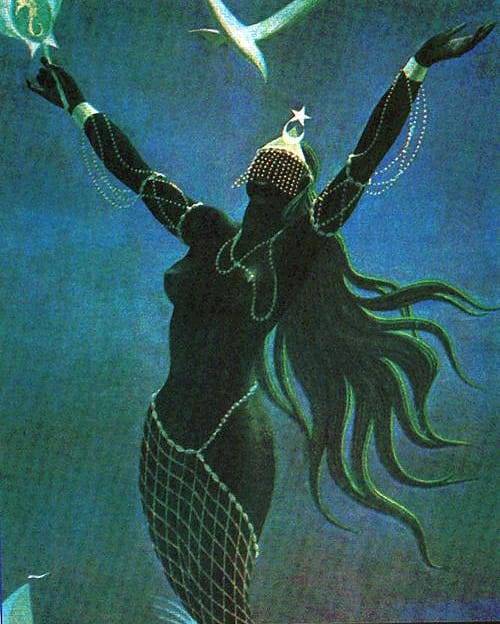
Holy Queen Sea
Yemaya, Queen of the Sea, epitomizes motherhood and rules all issues pertaining to women. She is among the most powerful and beloved of the Seven African Powers, the sexy matriarch of the Yoruba spirits known as orishas. The translation of her name, “The Mother Whose Children are Fish” has dual implications:
• Yemaya’s children are innumerable: she is the mother of most of the orishas.
• Her generosity and benevolence have also garnered her countless human devotees, equivalent to the innumerable fish of the sea.
Yemaya has profound associations with the sea and saltwater. She resides in the sea, she is the spirit of the sea, and she is the sea, literally present in ocean water. Her nature resembles that of the sea: profound, beautiful, filled with treasure and generosity but also potentially tempestuous. Yemaya generously bestows abundance, wealth, healing, love, and fertility, but she is also the essence of tidal waves and rip currents.
Yemaya, a profoundly powerful orisha, may be petitioned for:
• Anything possibly considered a “woman’s issue”
• Fertility and reproductive issues
• Protection from domestic violence, which she despises
• Protection when traveling over the sea
However, those who develop an especially close relationship with Yemaya must be extra cautious when actually near the sea. Communicate with her constantly when in the water or beside it. Remind her that you are human and must live on land. Yemaya doesn’t intend to cause harm but likes to keep everything she loves—her treasures—near her.
Once upon a time, Yemaya lived in the cemetery and Oya in the sea. Yemaya tricked Oya into permanently trading places. Oya has never entirely forgiven her. Do not feed or venerate them side by side. Leave some distance between these two powerful orishas.
Yemaya is syncretized to the Stella Maris and the Black Madonna of Regla.
Favored people:
Anyone of African descent whose ancestors survived the Middle Passage to the West may consider their connection to Yemaya established. It is traditionally believed that anyone who survived did so through her grace, while those who did not survive were received into her body.
Yemaya also protects:
• Women and children
• Practitioners of the occult
• Those born under water signs, especially Cancers
Also known as:
Yemalla; Yemoja; Yemalia; Yemaja; Iemanja
Origin:
Yoruba (Nigeria)
Classifications:
Orisha; Mermaid
Manifestations:
Whether manifesting as woman or mermaid, Yemaya is always spectacularly beautiful. She can be sexually provocative with a rolling, hip-swaying walk that evokes the sea. Her traditional costume includes seven skirts. Her hair, clothes, and body may be ornamented with crystals, pearls, coral, or tiny bells.
Attributes:
Seashells, marine motifs
Emblem:
Star and half moon; Yemaya is the only orisha associated with two heavenly bodies—one isn’t sufficient to represent her beauty.
Colors:
Blue, white
Birds:
Doves, ducks, peacocks
Creatures:
Fish, all sea creatures
Element:
Water
Metal:
Silver
Number:
7
Planet:
Moon, which controls the sea
Plants:
> Indigo, seaweed, water hyacinth
Minerals:
Quartz crystal, pearls, coral
Places:
Originally the spirit of Nigeria’s Ogun River, her profound associations with the ocean may have coincided with the African slave trade.
Day:
Saturday
Time:
• 2 February
• Summer Solstice •15 August (Brazil)
• 7 September (Cuba)
• New Year’s Eve and New Year’s Day. Midnight, the threshold between years, is her power moment.
Altar:
Devotees traditionally visit her at the ocean, bearing gifts. Alternatively, create an altar for Yemaya featuring saltwater and ocean motifs at home. Yemaya’s shrine should evoke the sea. Decorate it with nets, seashells, sea stars, and sea horses. Add salted water to a crystal glass containing small seashells.
Offerings:
Jewelry, perfume, brand new scented soap still in its wrapper; flowers, especially white roses. Yemaya’s favorite food offerings include wet seedy fruits like pomegranates and watermelon plus fish, duck, and lamb dishes. She likes to snack on pork cracklings, plantain or banana chips and pound or coconut cake. Garnish everything with generous libations of molasses. Gifts on behalf of the marine environment and sea creatures may also please her.
HOW TO PETITION YEMAYA
• Summon her with a gourd rattle.
• Petition her at the beach.
• Can’t get to the beach? Yemaya’s fellow water spirit, Oshun, spirit of sweet waters, will accept offerings on her behalf. Deposit gifts for Yemaya in flowing streams or rivers. Nothing is free, however: if utilizing Oshun’s services, be sure to speak to her first, explaining that you would like her to deliver your offering to Yemaya. Bring Oshun an appropriate gift, too.
YEMAYA CLEANSING SPELL
Re-create the sea: add sea salt to spring water.
• Murmur over it. Tell the water your goals and what you seek. Invoke, petition, or pray to Yemaya.
• Sprinkle the water over your naked body from head to toe using your fingers or a roseMary branch.
• Let the water remain on your body for a little while, and then gently pat yourself dry with a brand-new clean white towel or cloth.
• Put on clean clothes.
• Take the cloth to the sea with seven white roses; throw everything in the water.
• Walk away and don’t look back.
Although there is one Yemaya, she also has multiple paths, which may be venerated independently. Alternatively they may be understood as different facets of one extremely complex, profound goddess. Yemaya’s different paths are symbolized by different shades of blue (and sometimes by unique attributes). The particular hue represents each path’s specific natureand home. Thus the aspects of Yemaya who live closest to land or the water’s surface are represented by paler shades than those dwelling in the depths. Aggressive, violent aspects of Yemaya also claim the color red.
The following are but a few of her many aspects:
YEMAYA ASESUN
Yemaya Asesun, an ancient path of Yemaya, is Queen of Water Birds including ducks, geese, and swans. She rules the springs that gush forth from Earth, especially in deep forests.
Color:
Light blue
YEMAYA ASHAGBA
Yemaya Ashagba, “The Chain,” is Olokun’s first child and may be the oldest, most primordial aspect of Yemaya. (See Yembo below.) Queen of the Anchor, Yemaya Ashagba connects the bottom of the sea with the top. She is a spirit of divination and healing. When angered, floods, and tidal waves are her weapons.
Attribute:
Anchor
Color:
Light blue
YEMAYA ATAREMAWA
Yemaya Ataremawa, the queen who is ever so important, owns all treasures of the sea. She has a home in the forest.
Color:
Light blue
YEMAYA IBU AGANA
Yemaya Ibu Agana is a wrathful aspect of Yemaya who lives at the bottom of the sea where she churns destruction.
Color:
Deep blue
YEMAYA IBU ARO
Yemaya Ibu Aro distributes treasure. She controls trade routes and markets.
Colors:
Indigo blue, red coral
YEMAYA MAYALEWO
Yemaya Mayalewo, Queen of the Harbor, the One Who Tends to Commerce and Trade, lives at the bay’s entrance. She is queen of the marketplace, Oya’s prime competitor.
Color:
Light blue, teal
YEMAYA OGUNTé
Yemaya Ogunté is Warrior Yemaya: the courageous, fearless warrior who fights alongside Ogun. She lives on rocky, treacherous coastlines and wears a crown of seven machetes.
Color:
Midnight blue, red
YEMAYA OKOTO
Yemaya Okoto, the Pirate Queen, causes shipwrecks and drags ships and treasure down to the ocean floor. Her name means “the one who lives amongst the seashells.” Her crown is a shark’s jawbone. She clenches a dagger between her teeth. She rules all predatory marine creatures who serve as her messengers and servants, possibly including human pirates. Yemaya Okoto fills the sea with blood. The Red Sea is her official hideout, but she sails where she chooses. (To complicate matters further, Yemaya and her daughter, love goddess Oshun, may be alter-egos of Lady Asherah, another Red Sea Queen and her daughter, love goddess Astarte.) She is also known as Yemaya Ibu Okoto.
Color:
Indigo, navy blue, blood red
Altar:
Decorate with Jolly Rogers and pirate flags
YEMBO
Yembo may be Yemaya’s mother or the oldest form of Yemaya. Yembo may be the mother of the orishas. Because Ogun allegedly raped her, metal knives are not permitted in her presence or used in her offerings. Substitute crystal, stone, or wood
290 notes
·
View notes
Photo

REVIEW
Goddess Magic by Aurora Kane
A Handbook of Spells, Charms, and Potions Divine in Origin
Drawing down the moon is something I have done to take in the Goddess but have never done this with a specific goddess in mind, invoked or evoked. This book feels like an introduction with a bit about many goddesses, their powers and offerings they might like. The book suggests researching the goddesses in this book, finding a few that will enhance your life or magic working, incorporating intention, setting up an altar, believing, taking into consideration doing no harm, being patient as you listen and wait, and then being thankful. As mentioned, this feels introductory in nature and a good place to begin as one explores the realm of goddesses, how to know them better, incorporate them in one’s life and magic working.
The Chapters:
* Prologue
* Introduction
* Goddess Magic
* Goddesses of Love and Beauty
* Goddesses of Marriage, Fertility, and Motherhood
* Goddesses of Relationships, Truth, and Forgiveness
* Goddesses of Home, Hearth, and Healing
* Goddesses of Abundance, Good Fortune, and Prosperity
* Goddesses of Wisdom and Knowledge
* Goddesses of Strength and Protection
* Goddesses of Creativity and Joy
* Goddess Magic Spells and Rituals
* Epilogue
* Acknowledgements
* Resources and References
* Index
Thank you to NetGalley and Quarto Publishing-Wellfleet Press for the ARC – This is my honest review.
4-5 Stars
BLURB
Tune into the divine power of Goddess Magic, featuring a directory of deities alongside 50 spells, altars, and exaltations to amplify your highest vibes and attract fulfillment, success, friendship, growth, love, and fortune.
Goddesses, both new and old, will lend their powers to those who seek their favor. Goddess Magic helps you channel divine power while also helping you find your patron deity of choice. Connect with your spiritual heritage and tap into the powers of your ancestors and all the mystical beings around you.
This beautiful handbook contains well-known goddesses from the ancient world famously claimed by witches throughout the ages as well as other, less common ones, like catholic patron saints, around whom specific spells and rituals have grown. Each goddess rules over her domain, protecting and inspiring those who seek her favor with traditional rituals and spells praising her. Her symbols, favorite offerings, and favored forms of worship are all explained in the same illustrated and informative way as the previous books in the series.
Here is but a taste of the powerful patrons you can learn about:
HECATE is the Greek goddess of witchcraft and divination. Her roman counterpart is called TRIVIA and both accept offerings at crossroads. She transmits good news of the future, resides as a patron deity over divination spells. She’s an excellent guide for new ventures and is a powerful guardian.
KAMALA is an incarnation of the Hindu goddess Lakshmi, the goddess of wealth and creativity. Invoke her to bring creative skills so that you can fill your life with pleasure and wealth of every kind by offerings of rice and ghee.
MARIE LAVEAU may be the most influential American practitioner of the magical arts. The notorious Voudou Queen of New Orleans dispensed charms and potions (even saving several condemned men from the gallows), told fortunes, and healed the sick.
SAINT LUCIA is the bearer of light in the darkness of winter. She is the patron saint of the blind, authors, cutlers, glaziers, laborers, martyrs, peasants, saddlers, salesmen, and stained glass workers.
YEMAYA is the Yorùbá Orisha or Goddess of the living Ocean, considered the mother of all. She is the source of all the waters, including the rivers of western Africa, especially the River Ogun. She is associated with the Orisha Olokin (Who is variously described as female, male, or hermaphrodite), Who represents the depths of the Ocean and the unconscious, and together They form a balance. She is the sister and wife of Aganju, the God of the soil, and the mother of Oya, Goddess of the winds.
The Mystical Handbook series from Wellfleet takes you on a magical journey through the wonderful world of spellcraft and spellcasting. Explore a new practice with each volume and learn how to incorporate spells, rituals, blessings, and cleansings into your daily routine. These portable companions feature beautiful foil-detail covers and color-saturated interiors on a premium paper blend.
Other titles in the series include: Witchcraft, Moon Magic, Love Spells, Knot Magic, Superstitions, House Magic, and Herbal Magic.
1 note
·
View note